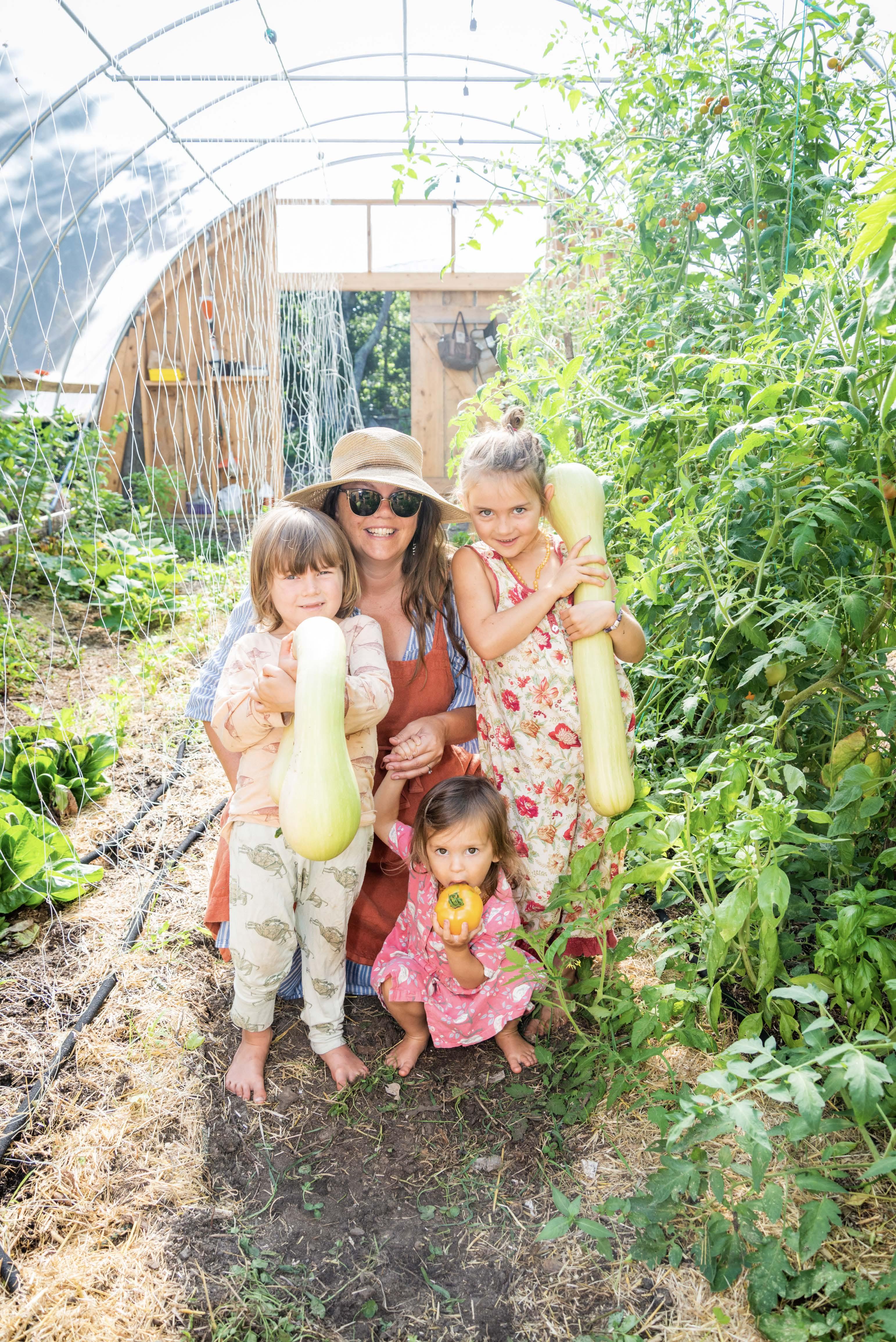
HOOP HOUSE HOOPLA Cre ati ve Space at Home • Historic Restoration Cooking at Outermost Inn • Cozy Solutions LET'S GO ANTIQUING! An Island Guide Growing more, growing longer
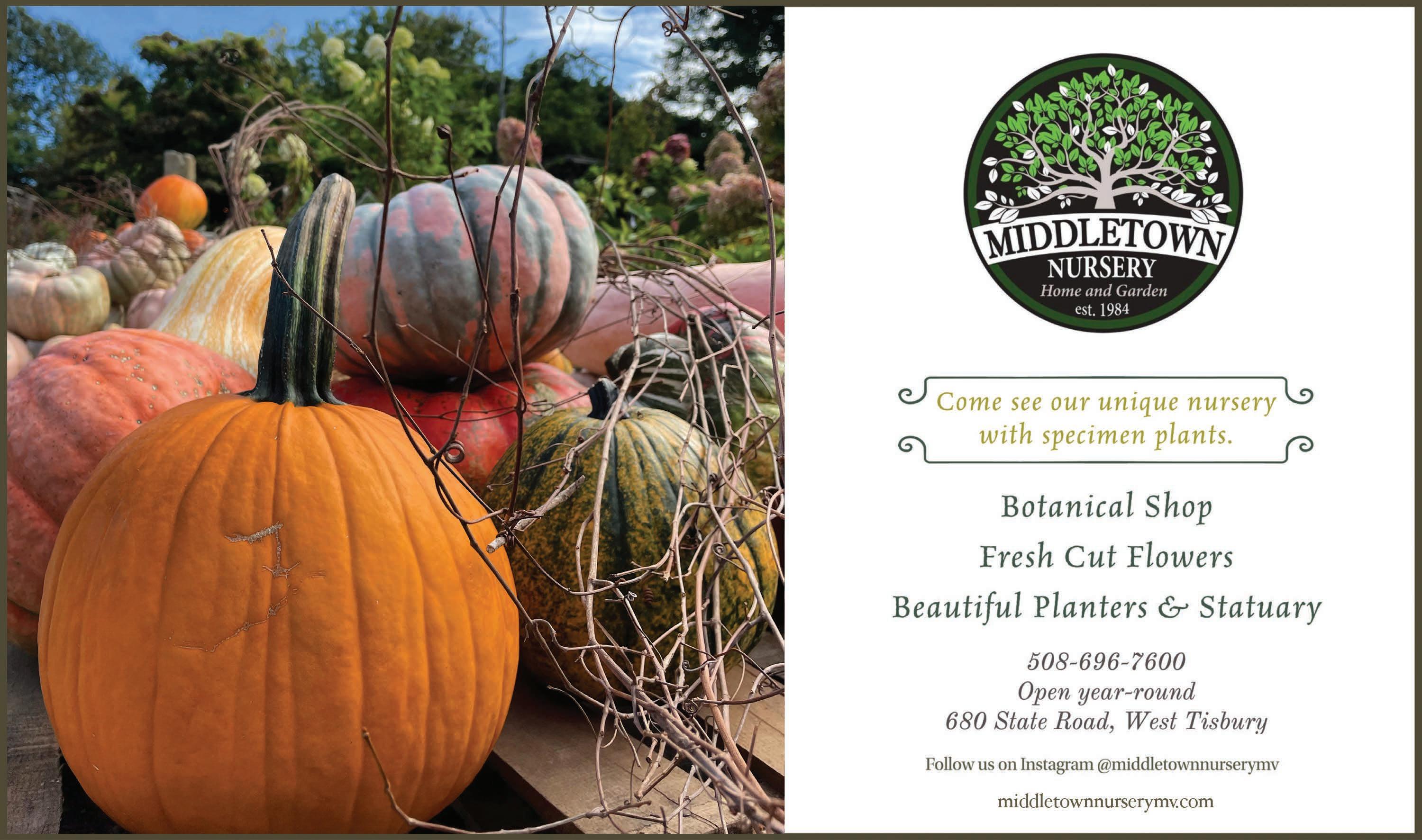

Page 2 · THE VINE


THE VINE · Page 3
Features
14 The Hunt is Half the Fun
Decorate with second-hand art and antiques to add Vineyard character to your home.
BY THOMAS HUMPHREY
18 CREATIVE SPACES: Making Room for Babies
Photographer Maria Thibodeau gets the home studio of her dreams.
BY JANET NEWTON
20 What's All the Hoopla about Hoop Houses?
A low-tech alternative to a green house can extend your growing season and boost summer bounty.
BY THOMAS HUMPHREY
From the Editor
House to Home
Whether you’re restoring an old house, decorating a new one, or simply creating a cozy space to call your own this winter, The Vine is here to help. What better way to turn a house into a Vineyard home than filling it with Island antiques and art? Hunting for one of a kind objects is half the thrill; consider our story on page 14 a treasure map.
If you’ve ever wanted to carve out room for a hobby, a craft or a side business, our new feature titled Creative Spaces is for you. In this issue, we get a peek on page 18 at Maria Thibodeau’s photo studio, which she designed especially for photograph ing her favorite subject matter: babies. And if you’re just looking to make a spot in your home a little more winter-friendly, find ideas in Hearth & Hygge, page 5.
What if the space you need is outside –room to grow more vegetables or flowers or other plants? A hoop house might be the solution. Discover the pros and cons of this kind of garden structure in our sto ry on page 20.
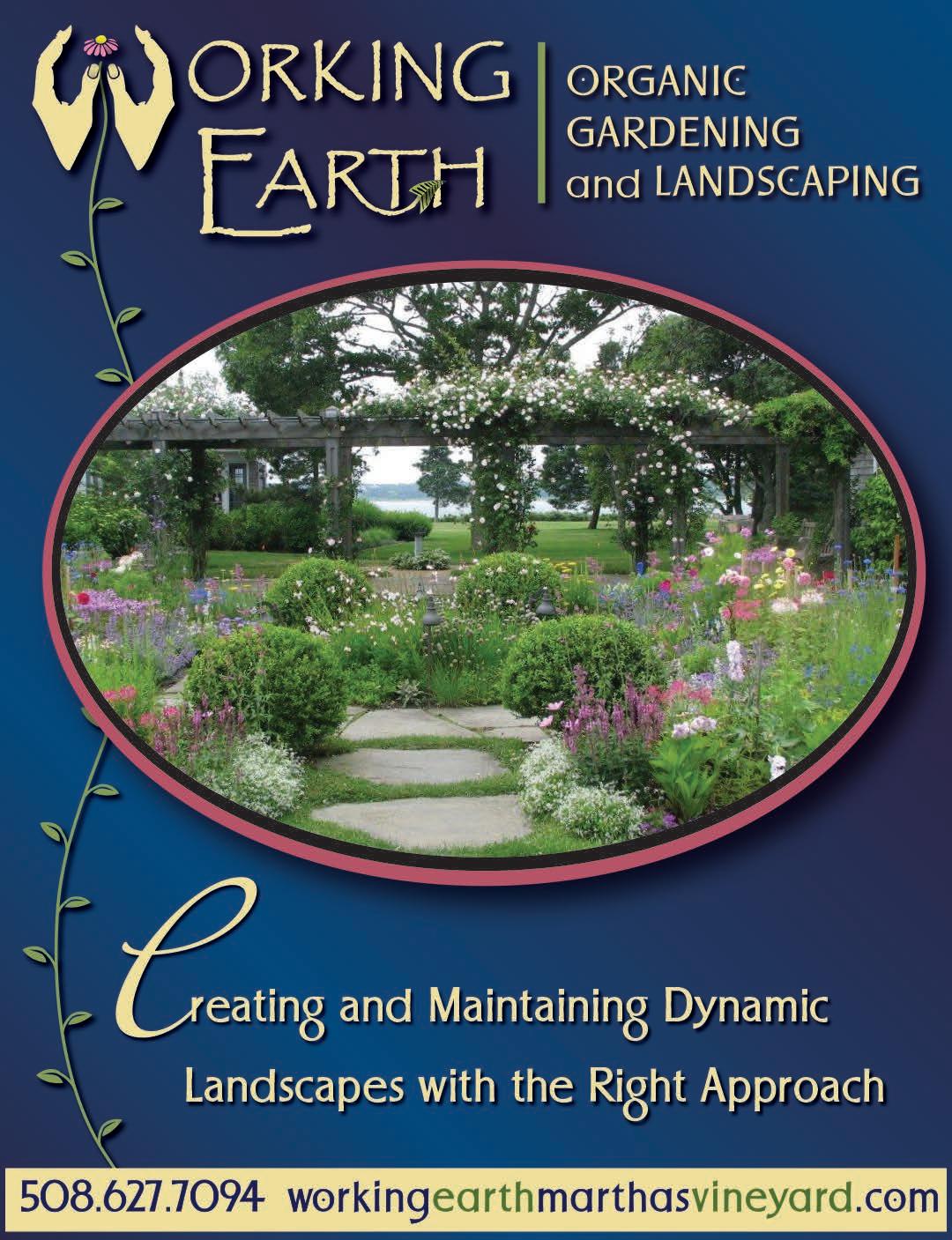
Lastly, don’t miss Sissy Biggers’ timely interview with architect Josh Gothard on page 10, and Elizabeth Bennett’s catch-up with chef Scott Grewe at the Outermost Inn on page 8.
Welcome to the cozy season!
–Susie Middleton
Departments
4 Editor’s Note
5 On the Rock
Hearth & Hygge
10 Q & A
With an Eye to History: An Interview with Josh Gothard
8 Vine & Dine
At the Helm: Outermost Inn executive chef Scott Grewe
23 By the Numbers Land ho!
Cover photo: Rachael Ewing with Silas, Maizey and Mirabai Ewing. Photo by Ray Ewing.
THE VINE
EDITOR Susie Middleton
ART DIRECTOR Jared Maciel
CONTRIBUTORS Elizabeth Bennett, Sissy Biggers, Chris Burrell, Ray Ewing, Nicole Fullin, Thomas Humphrey, Janet Newton, Jeanna Shepard, Maria Thibodeau
PUBLISHER Jane Seagrave
BUSINESS MANAGER Sarah Gifford
DIRECTOR OF SALES & MARKETING Skip Finley | sales@mvgazette.com
SALES TEAM Frederica Carpenter, Garrett Burt, Carrie Blair
MARKETING MANAGER Alessandra Hagerty
AD PRODUCTION Jane McTeigue, Jared Maciel, McKinley Sanders
Copyright 2022 by the Vineyard Gazette Media Group. No part of this publication may be reproduced without the written permission of the publisher.
To subscribe to the Vineyard Gazette, visit vineyardgazettestore.com

Vineyard Gazette Media Group P.O. Box 66, 34 So. Summer Street, Edgartown, MA 02539 thevine@mvgazette.com | 508-627-4311

Page 4 · THE VINE CONTENTS, FALL HOME AND GARDEN 2022
Hearth and Hygge
The cozy season is here, and as the Dan ish would say, it’s time to get your hygge (hoo-gah) on, whether it be with a warm blanket or scarf – or an actual fireplace.

Magic Carpet
Next to a roaring fire, a welcoming hearth needs a warm, richly colored carpet –such as this Tibetan village rug from Rin po in Vineyard Haven.
The rugs, which are designed as part of a Tibetan refugee project in Nepal, go back to Rinpo manager Tenzin Sonam’s roots: his father fled Tibet for Nepal at the age of 15 and his mother was born in a Tibetan refugee camp. Tenzin has visit ed the rug makers; the family who makes them operates out of a Nepalese building where a few of his relatives live.
“I remember going there as a kid and seeing them hose down rolls and rolls of red yarn,” Tenzin says, describing the process of vegetable dyeing that the rug makers use to give the yarn its unique, earth-tone colors. The process also gives the rugs more resistance to fading.
Every rug is unique, with composi tions of miniature villages, huts, animals and trees each telling a different story. Rugs range from $599 to $1,000. Rinpo, 54 Main street, Vineyard Haven
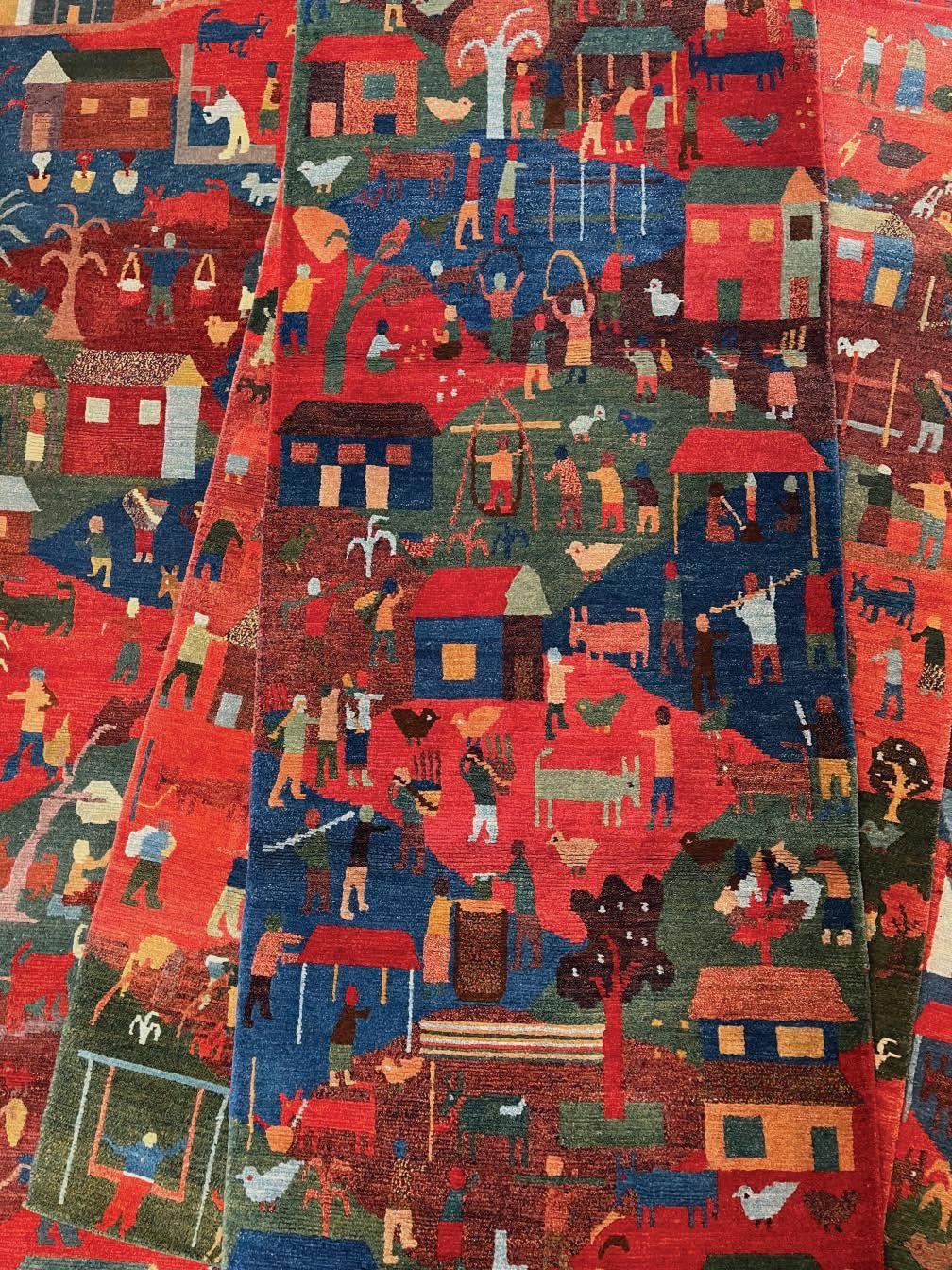
Infinite Warmth
If you’re just setting up your winter space now, you probably didn’t spend much time knitting by the fire last winter. Fear not! Islander Debby Ware of Pasture Prime spends all winter knitting warm, one of a kind woolen accessories.
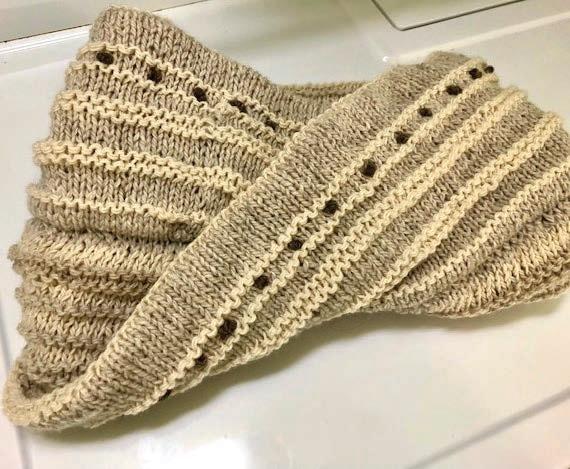
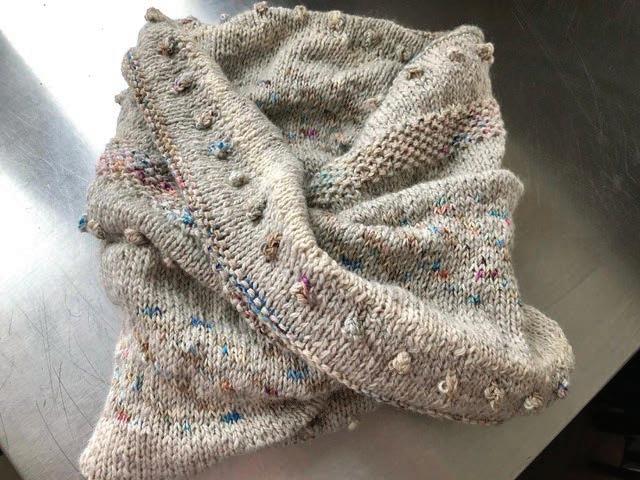
They’re for sale at the West Tisbury Farmer’s Market (through October).
All of Debby’s wool is sourced onIsland from the flock of Dr. Michael Jacobs, a 40-year Island physician who has taken up shepherding since his retirement in 2011. Debby and Dr. Jacobs came together at a chance encounter at the farmers’ market, when Debby spotted his table laid out with a wool unlike any she had seen before.
Dr. Jacobs raises Cormo sheep, a relatively new Tasmanian sheep breed.
“They were bred just for their wool, which is this wonderful high end, lovely, lovely wool,” says Debby. “It’s the talk of the yarn world. It comes in this delicious natural gray color.”
Debby most enjoys knitting items like children’s hats ($40-70) and sweaters ($120) because of the wacky designs she comes up with “off the needle.” Some of her bestselling items are her adult cowlneck scarves. The large twisted mobius or infinity cowl is $400; smaller scarves start at $90. You can find Debby on Instagram @debbyware.
Turn on the Heat
In the ideal world, a fireplace would be at the center of every cozy cold weath er room. “Who doesn’t love fire?” says Patricia Giumarra, owner of Vineyard Hearth, Patio and Spa. “It’s in our DNA.”
Gas fireplaces are an extremely pop ular option, says Patricia. “They aren’t only aesthetically pleasing, they’re also immune to power outages.” Installation of a gas fireplace, however, requires ei ther an existing brick fireplace or signifi cant new construction.
For customers who want the look and feel of a gas fireplace with a less inten sive installation process, Patricia recom
Pile on the Fleece
A warm blanket or soft throw is a cold weather essential. At Faherty in Edgar town, you’ll find blankets appropriate for both a cold autumn night at the beach or a toasty evening by the fire. One es pecially warm option is the recycled High Pile fleece blanket, which is recy cled plush fleece on one side and organ ic cotton on the other. Many of the cus tom-woven designs were developed in collaboration with Native designer Doug Good Feather, a member of the Standing Rock Lakota and the Dakota nations. A portion of the proceeds from sales go to his Lakota Way Healing Center. High Pile blankets are 52” x 72” and cost $168. Fa herty, 17 North Water street, Edgartown
mends a freestanding stove, which only requires an outflow vent. These standalone cast iron gas stoves, similar in con struction to wood-burning stoves, vary in price from $2,500 to $5,000.
One model that's regularly avail able at Vineyard Hearth is the Vermont Castings Radiance Direct Vent ($4,599), above. It’s the largest model and offers 25,000 to 38,000 BTUs. Another Ver mont Castings model in black matte, the Stardance, offers 20,000 to 28,000 BTUs and costs $3,799. Both models feature a blower fan to circulate heat throughout the house. Vineyard Hearth, Patio and Spa, 455 State Road, Vineyard Haven

ON THE ROCK
Debby Ware




Page 6 · THE VINE


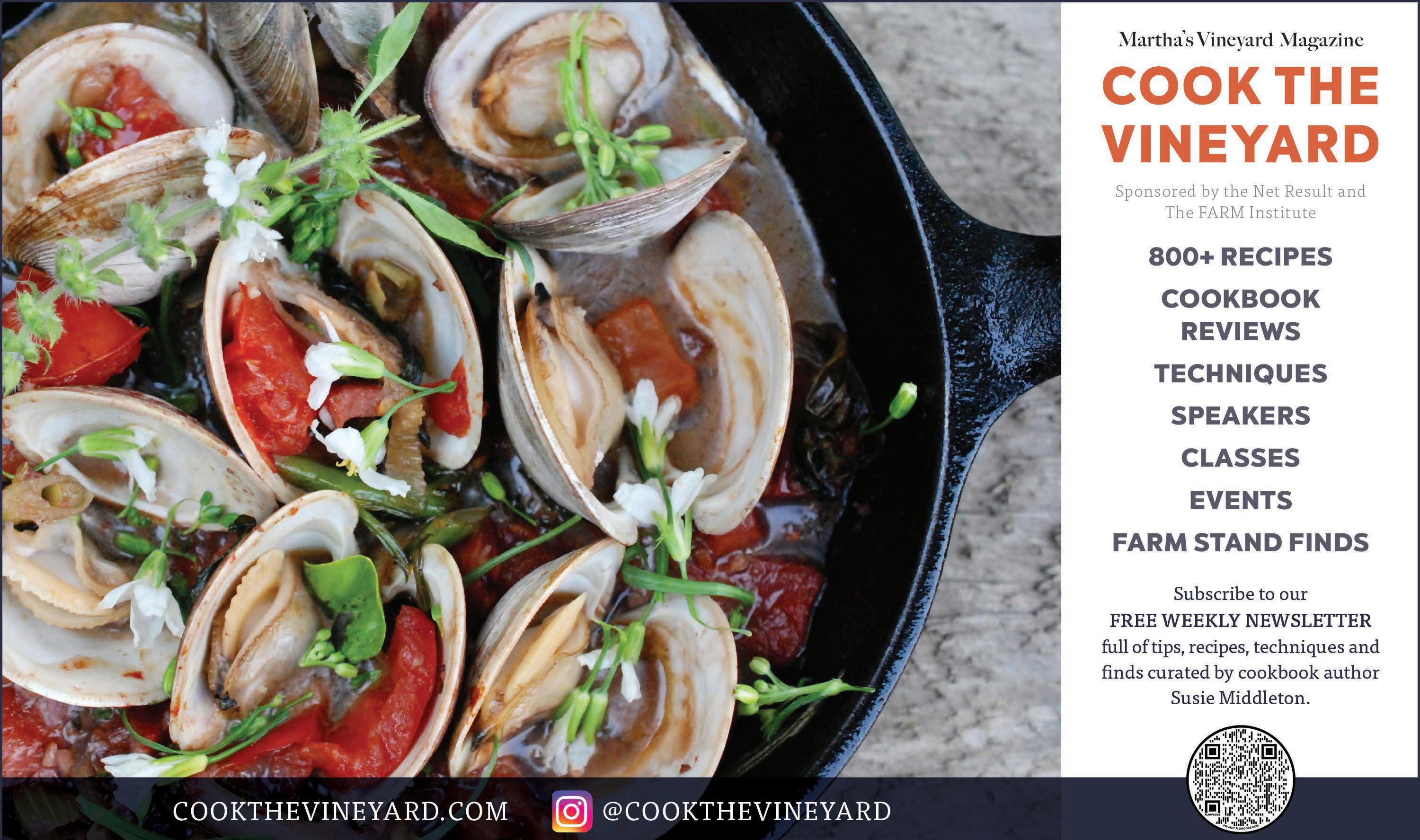
THE VINE · Page 7
At the Helm
In season, executive chef Scott Grewe steers the kitchen crew at the Outermost Inn; off-season, he and his wife Elizabeth live aboard their 36-foot sloop.
BY ELIZABETH BENNETT • PHOTOS BY JEANNA SHEPARD
The story of how executive chef Scott Grewe found his way to the Outermost Inn in Aquinnah is a very Vineyard tale involving Caribbean waters, friendly neighbors on the next boat over and a web of friendships between homeown ers on distant islands.
For the last two summers, Scott has worked as Outermost’s executive chef and he and his wife Elizabeth have called the inn their home. The spacious, sunfilled kitchen gives him views of big sky and the backyard’s osprey pole. Some days the sunlight can be blinding when it hits a sauté pan at a particular angle.
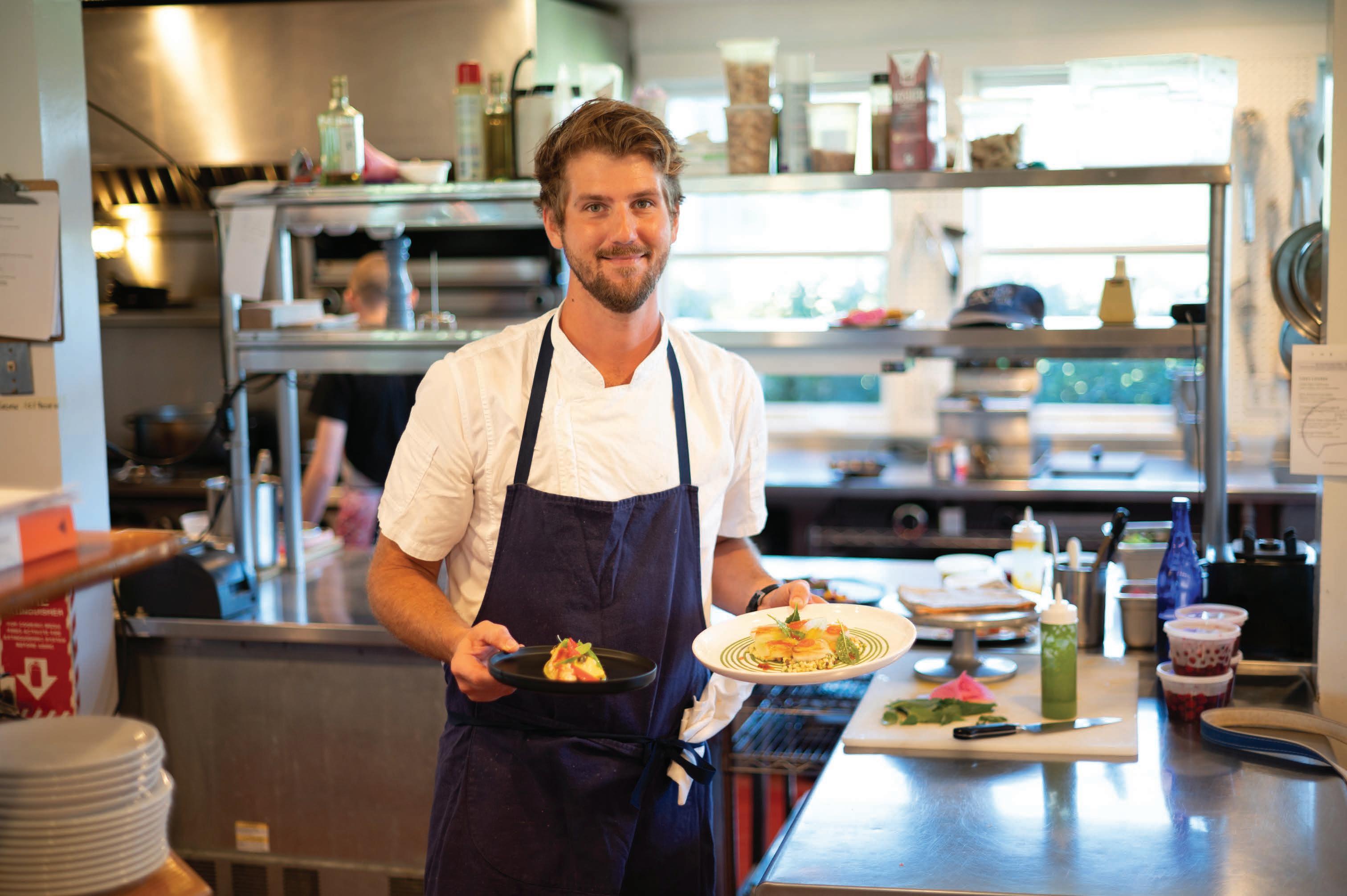
A kitchen with expansive views is rare in the professional experience of this young chef who has put in years at kitchens ranging from Chili’s to his own fine dining establishment on the Upper East Side of Manhattan.
Scott grew up in Florida where he
began working in kitchens at age 13 as a dishwasher. After working at chain and Italian restaurants, he decided to “do it right” and attend cooking school. Tuition a challenge but loans made it possible for him to attend Florida Culinary Institute.
“At school, I was surrounded by people who were excited about cooking and who were nerding out on what the newest restaurants were, what the trends were and where they were going to go after school. I loved it,” he says.
After seven years at the Ritz Carlton in Sarasota, Scott began cold calling Mi chelin-starred restaurants in New York city, asking to do a stage (unpaid intern ship). An offer to stage at Jean-Georges led to stages at other legendary restau rants such as Le Bernardin – and then a permanent job offer from Jean-Georges.
Scott worked hard there for a year and a half before Chef Marcus Ware – known
in these parts as executive chef at Grey don House on Nantucket – brought Scott in as a sous chef at Aureole, a fine dining restaurant in the Theater District. “Mar cus took me under his wing,” he says. “He trusted me and let me create menu items. I was there for three years and it was a great experience.”
An investor seeking to open a brown stone-based fine dining restaurant in one of Manhattan’s most exclusive neighbor hoods sought out Scott to be the chef. Having his own place appealed, and Scott opened Sutton Inn in 2014. But he didn’t anticipate how consuming the en deavor would be, despite the small, fo cused menu and neighborhood vibe.
“It was hard,” Scott recalls. “I was cooking and general managing. I had a little workshop upstairs where I was cur ing meats and charcuteries. We adopted a no tipping model before Danny Meyer did and people just didn’t agree with it. Everyone quit.” Scott recruited friends to work as wait and kitchen staff, and even served tables himself.
Scott and Elizabeth began preparing for the next phase of their life: restoring a Contest 36 sloop to live aboard. For two years, the chef woke at four a.m., took a train from East Harlem out to Stamford,
Conn., worked on the boat, returned to the city and did full dinner service at Sutton Inn. When the restaurant closed in 2019, the Grewes took the opportunity to follow their dream and set sail for California.
At one stop in the Caribbean, they were anchored next to friendly neigh bors who mentioned Hugh and Jeanne Taylor. The Taylors, they said, were al ways on the lookout for outstanding kitchen talent. Through those friends, Scott also learned an odd coincidence: he’d previously anchored right in front of the Taylors’ own Bahamas property for a while. The Outermost – and Mar tha’s Vineyard – seemed to be in his fu ture. He helmed the Outermost kitchen for the summer of 2021 and returned for 2022.
The Outermost is perched north of the Gay Head Cliffs. Hugh and Jeanne Taylor are its longtime property own ers and established the inn 30 years ago. Daughter Alex Taylor manages the restaurant business. Dinner is a three course, prix-fixe menu. The Taylors give the chef few mandates – a steak item and a lobster item are the only requirements – leaving plenty of room for creativity.
Scott designs his menu with what’s fresh and available. There’s enough con
Page 8 · THE VINE
Executive chef Scott Grewe in his natural habitat at the Outermost Inn.
sistency to please diners returning for an annual visit and enough variety to delight the regulars who have standing reservations once a week. He’s excited about what’s been available this year through the MV Seafood Collaborative, and he loves having access to items such as fresh nasturtium blossoms, grown by Gabby Camilleri in Outermost’s garden.
Scott is quick to praise the talents of his kitchen team, from sous chef Connor Murtagh – who’s been with him since Sutton Inn – to pastry chef Liz Anderson to Island-based dishwasher Omar Pravia Saborio, who Scott describes as having washed “every single dish” in the Outer most building. “Connor and Omar are my rocks,” he declares. “It’s literally impossi ble to do what we do without those two people.”
Bringing the talented kitchen crew to the Vineyard wouldn’t be possible without a major perk offered by the Taylors: on-site housing. “The Taylor family is amazing. They treat us extremely well,” Scott offers.
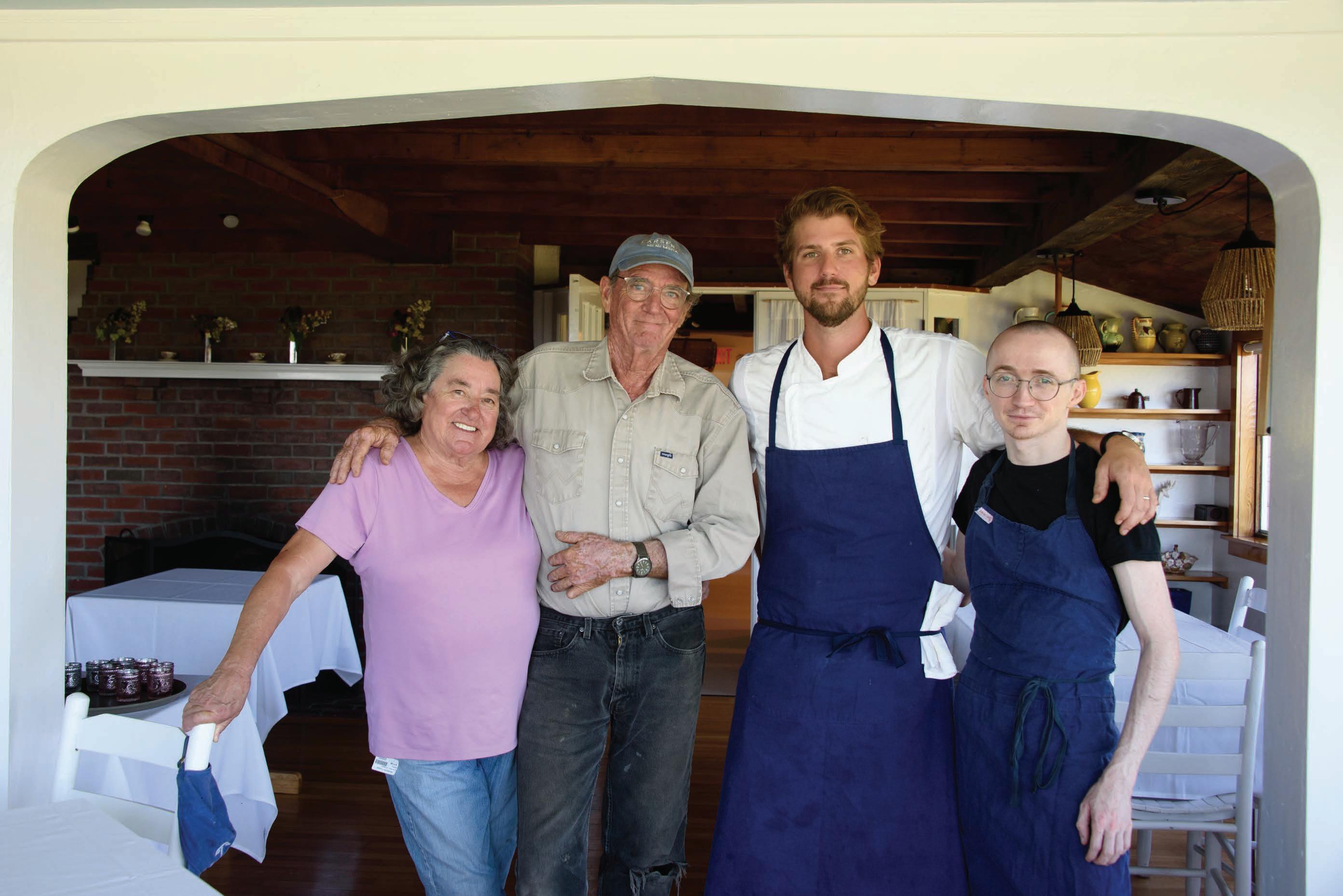
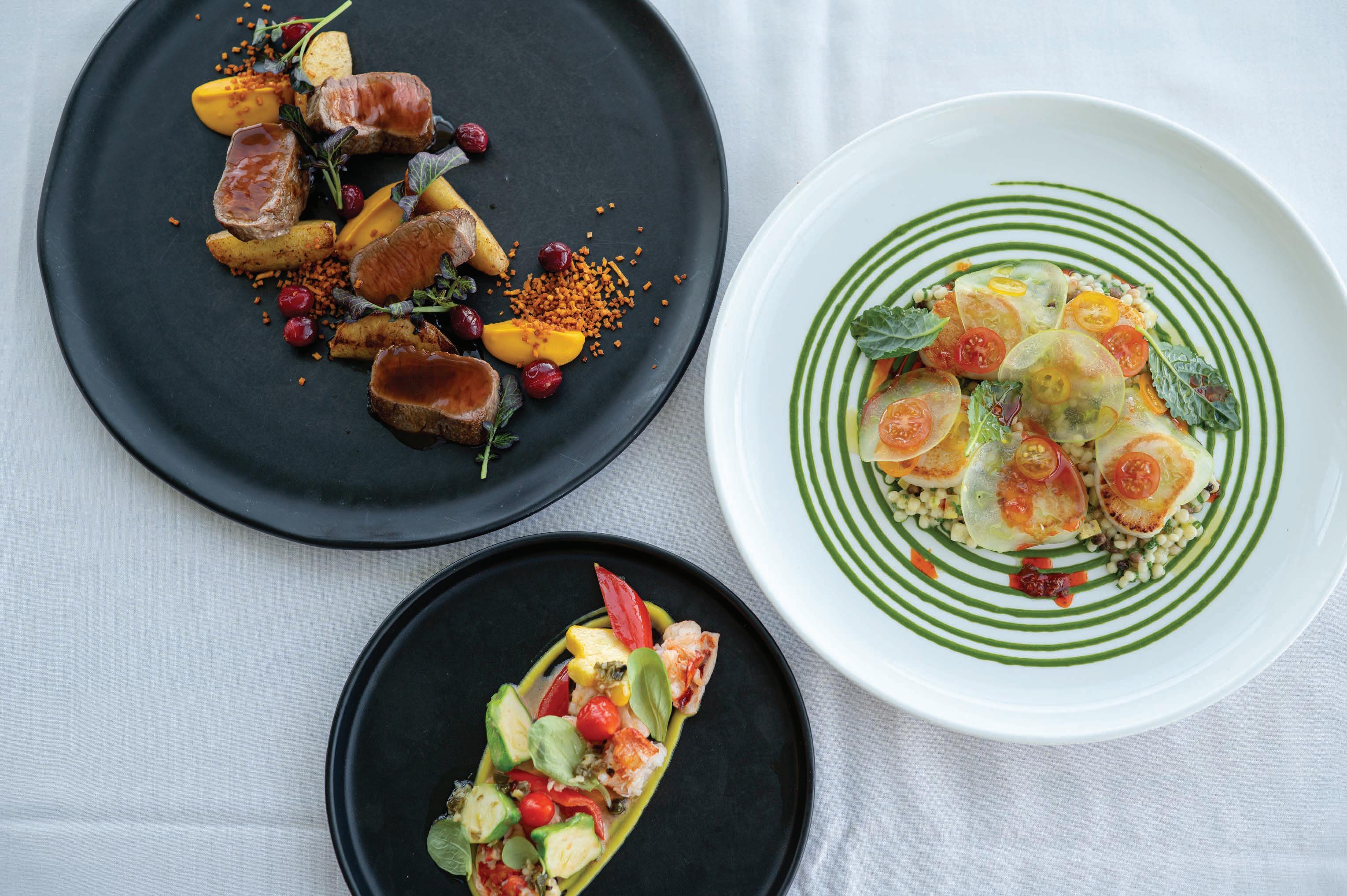
On an early September evening, the Outermost menu was full of reminders of
the change in seasons. Scott and his team had just shifted into a menu that retained summer ingredients – lobster, scallops, swordfish, herbs – but that were joined by autumn flavors. A crispy lobster fondue featured hearty chunks of lobster meat in a feuille de brick wrapper atop a rich sauce of melted gruyere, butter and apple, topped with fresh frisee. A new dish featured tri angular towers of venison accompanied by sweet potato puree and ruby red, perfectly circular cranberries. From the dessert sta tion, Liz scooped out mulled wine sorbet, combining the iciness of summer with deep, rich tastes of fall.
As the Outermost team makes prepa rations for the last dinner service of the season, Scott’s thoughts turn wistfully to what’s ahead. It’s not the next meal or kitchen but the 1,500 miles he and Eliz abeth expect to log while sailing their boat over the winter. He probably won’t mind its galley kitchen and he’ll certainly enjoy the adventure.
Elizabeth Bennett is community editor for the Vineyard Gazette.
THE VINE · Page 9 VINE & DINE
TOP: Outermost's late summer dishes (above) incorporate fall flavors and ingredients into dishes starring venison, lobster and sea scallops. BOTTOM, LEFT TO RIGHT: Outermost Inn owners Jeanne and Hugh Taylor with executive chef Scott Grewe and sous chef Con nor Murtagh.
With An Eye to History
AN INTERVIEW WITH JOSH GOTHARD
BY SISSY BIGGERS
Josh Gothard’s parents came from En gland to the Vineyard on an architectural photo shoot in the early 1980s. While on location, they rented an 1840s Victorian Greek Revival on Music street in West Tisbury – and never left. Josh’s birth made him a first-generation Islander and ultimately a graduate of Martha’s Vineyard Regional High School. In 2017 a Vineyard Vision Fellowship supported his master’s thesis at Parsons School of Design, in which he developed an ar chitectural language to address coastal resiliency in the restoration of historic buildings.
On the way to becoming an architect, Josh also spent time at sea, gaining his Coast Guard captain’s license which brought him to historic seaside towns on the East Coast and to coastal com munities as far as the West Indies.
We recently met at the Grange Hall in West Tisbury, just around the corner from his childhood home where he and his wife Grace now reside – as do the offices of his historic restoration archi tectural firm, Music Street Architects.
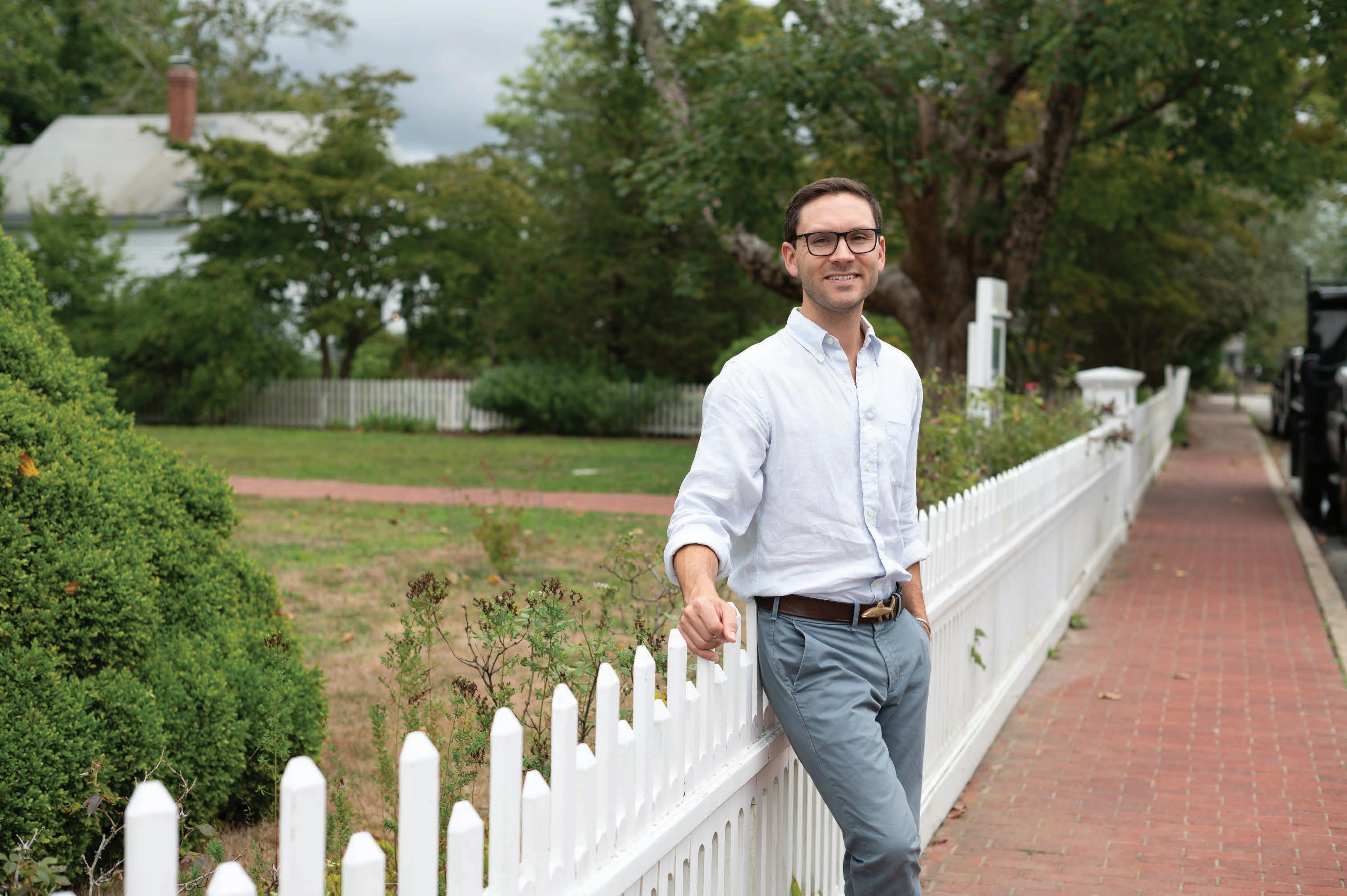
A. I have lived there all my life, except for the time away at college and grad uate school. The main house shares the property with two very old timber framed barns where my office is now. Some of the interior in the larger barn is from reclaimed shipwrecks. You can see the old, curved ship knees that hold up the second floor, and some of the rafters are quarter-sawn round masts, sliced thin and sistered together to make a larger beam. At the time, they just used the materials they had.
Vineyard Preservation Trust the build ing hasn’t changed so much!
Q. When did you start to feel a responsibility for your uniquely historic home?
A. I think I especially gained an appre ciation for the materials when I went off to Boston and New York where, for the first time, I lived among all these new builds. In most places you might be living in an historic structure with a completely new interior, but on the Vineyard, there are a lot of houses with an historic aesthetic on the exterior that also have interiors that are still original.
Q. A Vineyard home with 200 years of history has historic details from its original era as well as embellishments added in later years. How do you pick and choose and find the balance of the old, older and oldest?
come in and out of fashion and get add ed on and then stripped off.
Q. Does the quality of the materials dictate choices in starting a renovation?
A. Removing some of these pieces of time that are of lesser quality is a good starting point. You can hone in on the different eras like the 1950s and 60s where cheap materials and the quality of the detail work wasn’t there.
A lot of it has to do with the client and how far they're willing to go. I work with them to choose a snapshot in the history of the house and restore it to that time.
Q. What is the best advice for someone contemplating a restoration process?
A. Start from the overall structure of the building to ensure that it is going to stand for another two hundred years! Make improvements so it is structurally sound and save as much of the structure and the form because that’s what gives the Island and the property character.
A. I would walk to Alley’s every morn ing, sometimes with our neighbor David McCullough who was on his way to get the paper as I headed to the porch
A. That is hard to do because if you look at a span of historic photos of the houses in the Vineyard villages, there are different iterations of the same
Q. What are the latest in novations in the historic preservation process?
A. There are advances in the technol
Page 10 · THE VINE
Q. I would imagine your childhood home instilled an early appreciation of historic buildings.
Q. That must have been a fun place to play – not to mention your proximity to Alley’s General Store!
Jeanna Shepard
ogy for research – incredible archives are being developed on the Island and throughout historic districts – where you can find photos of your building organized chronologically. With some projects the focus is on bringing back the most iconic elements of the build ing. You don’t have to bring them all back unless you are dedicated to a com plete preservation.
Q. Are there new building materials that have an historic aesthetic with an increased longevity?
A. I think natural material is a better solution – using real wood siding and, ideally, wood roofing. Obviously, there are cost implications, but some of those materials have a similar lifespan as syn thetic. If they are preserved and main tained properly, it brings back the fabric that makes the Vineyard so special.
Q. Help me with a few definitions: What is adaptive reuse?
A. Taking an older structure that was used for one thing – like a boat shed or an agricultural barn – and converting it into something else like a residential set
ting, an office or a movie theatre.
Q. What is coastal resiliency in architecture?
A. It’s not just about building materials.
It’s about where the land and sea meet and the effect on architecture and infra structure such as seawalls and dunes.
The thing I tried to focus on with the [Vineyard Vision] fellowship was how to create a higher level of resiliency on our coastlines in a way that references his toric building techniques, so the overall fabric of that coastline doesn’t change dramatically.
Q. How did your experi ence as a Coast Guard cap tain influence your design work?
and Islander status give you an advantage in a partnership with a client?
A. I think it helps strengthen their understanding that we really focus on creating a home for them – whether it is incorporating a new structure or a reno vation – with a special knowledge of the vernacular of our neighborhoods.
Q. A high-profile exam ple of that would be your restoration of the Dragonfly House on busy Seaview avenue in Oak Bluffs. For those of us who live in Oak Bluffs, it was fun to watch!
neighbors. What advice do you have for homeowners facing this process?
A. Try to pool together as many of the historic precedent images for your property and form a catalogue to use in your presentation to the boards to explain why you are bringing some elements back and not others. From a neighborhood aspect, if the building is going to have additions, try to focus on keeping the most historic elements in a more prominent position to preserve the feeling and fabric of the neighbor hood.
A
. From seeing so many coastal com munities and the aesthetic change from one to the other, I developed a sem blance of a coastal language and learned to appreciate that these self sustaining communities should be the basis for our future! And being on board a ship really makes you focus a lot more on efficient use of space and the materials.
Q. Does your upbringing
A. It was a wonderful project for a ter rific family who really cared about the history of that structure and bringing it back as much as they could. There were a lot of changes made to that building to adapt to today's lifestyle but we tried to keep as many historical elements as possible in more prominent positions.
Q. You and your clients face the rigors of Island zoning, historic review boards and the opinion of
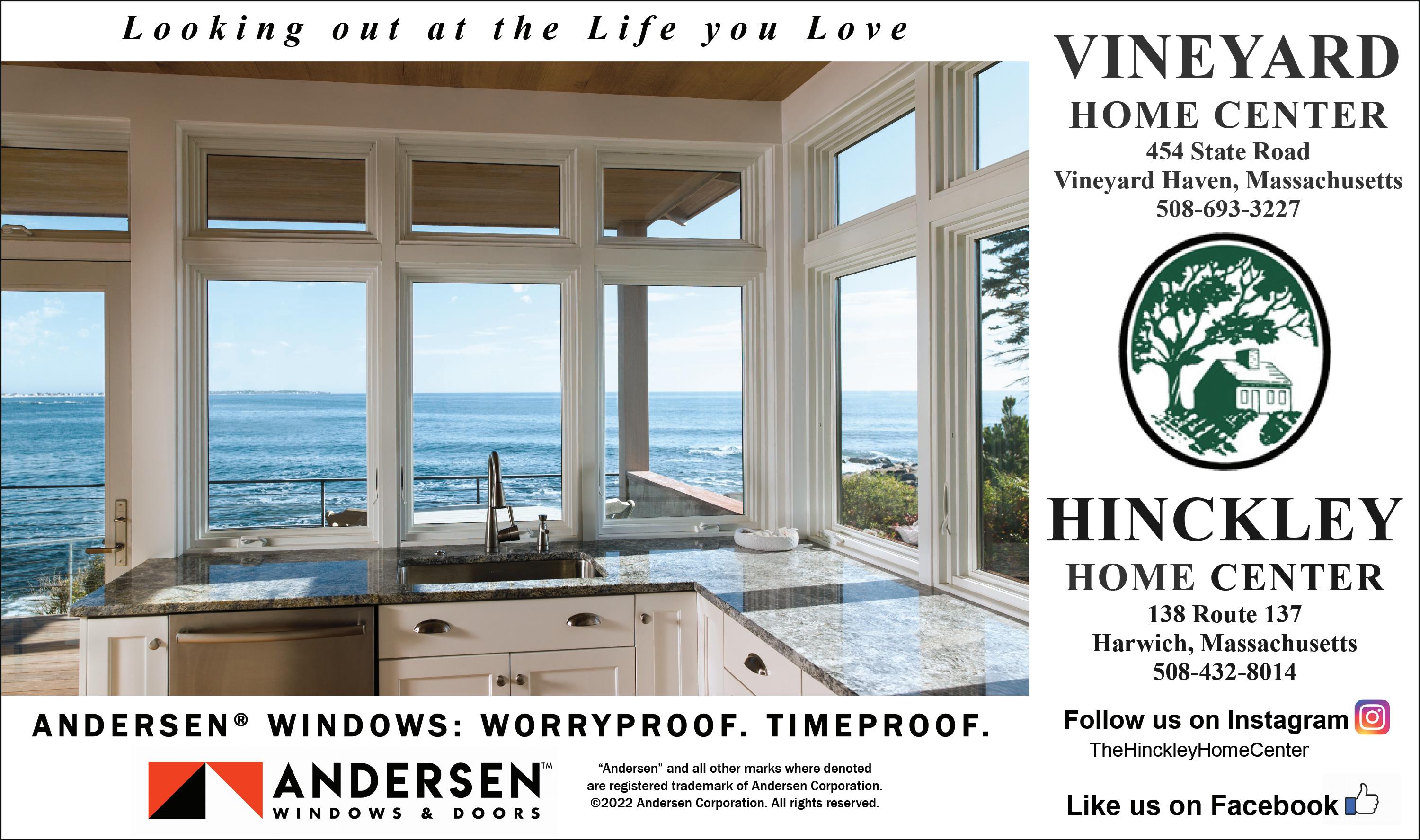
Q. Those who've been through the process know that sometimes the best laid plans can still get pushback.
A. This sounds corny but people say a good haircut is when nobody really notices you’ve had something done. It’s just the same in a renovation project. Do as much as possible without changing the overall character of the property.
Sissy Biggers writes regularly for The Vine and Martha's Vineyard magazine.
THE VINE · Page 11 Q&A / VINEYARD VOICES




Page 12 · THE VINE




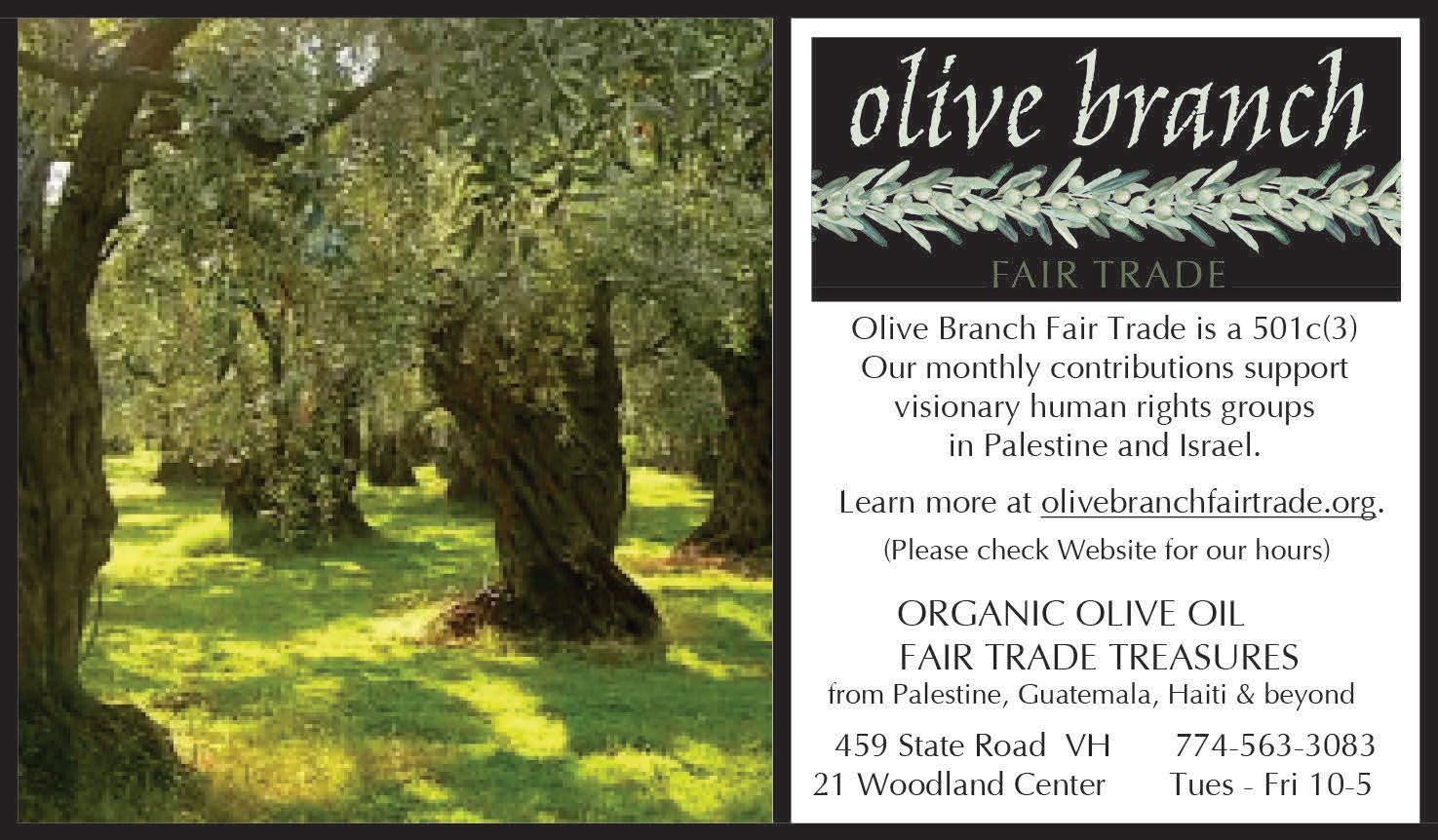

THE VINE · Page 13
The Hunt is Half the Fun
Decorating with second-hand objects and art is a clever way to infuse your home with Vineyard character. But first you’ll have to go hunting.
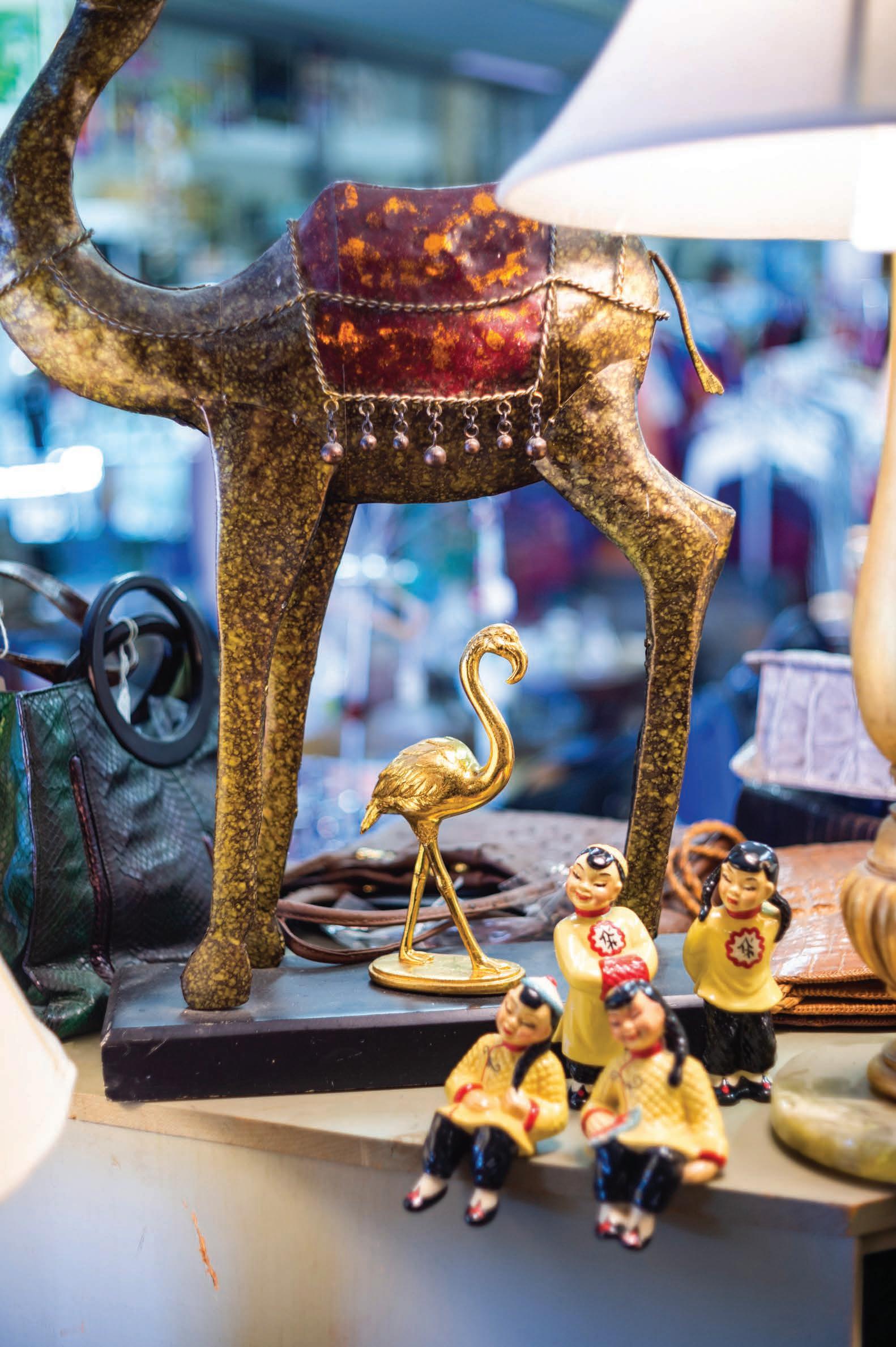 BY THOMAS HUMPHREY • PHOTOS BY RAY EWING
BY THOMAS HUMPHREY • PHOTOS BY RAY EWING
Decorating or redecorating your house is an exciting proposition – and a po tentially exhausting one. It can take a lifetime to cultivate a homey feel, to de velop Vineyard character for your Island home. But perhaps there is a shortcut you can take, thanks to those purveyors of time-worn, well-loved furniture and art – dealers in antiques and oddities that capture the spirit of this Island. As a bonus, when you furnish with antiques, the hunt is half the fun.
The story of a place is best told through its objects; at least that’s the impression an antique dealer will give you. Every ticket stub recalls a revered local venue, every landscape painting is a glimpse at the Island through the eyes of a folk artist. Ask a dealer about any item and out will come a tale of history, an elaborate exaltation of the virtues of wicker chairs or rusted eel spears.
“Everything is interesting to me, that’s my problem,” said John Robert Hill,
tucked away in a nook of yet to be sort ed antiques at his Vineyard Haven store, Second Treasures MV. The morning is always a blur for John, who scrambles to set up new acquisitions as early shop pers clamor to get in. His collection, al ready brimming with furniture, art and artifacts, is backed up by another packed warehouse that he maintains on the Is land.
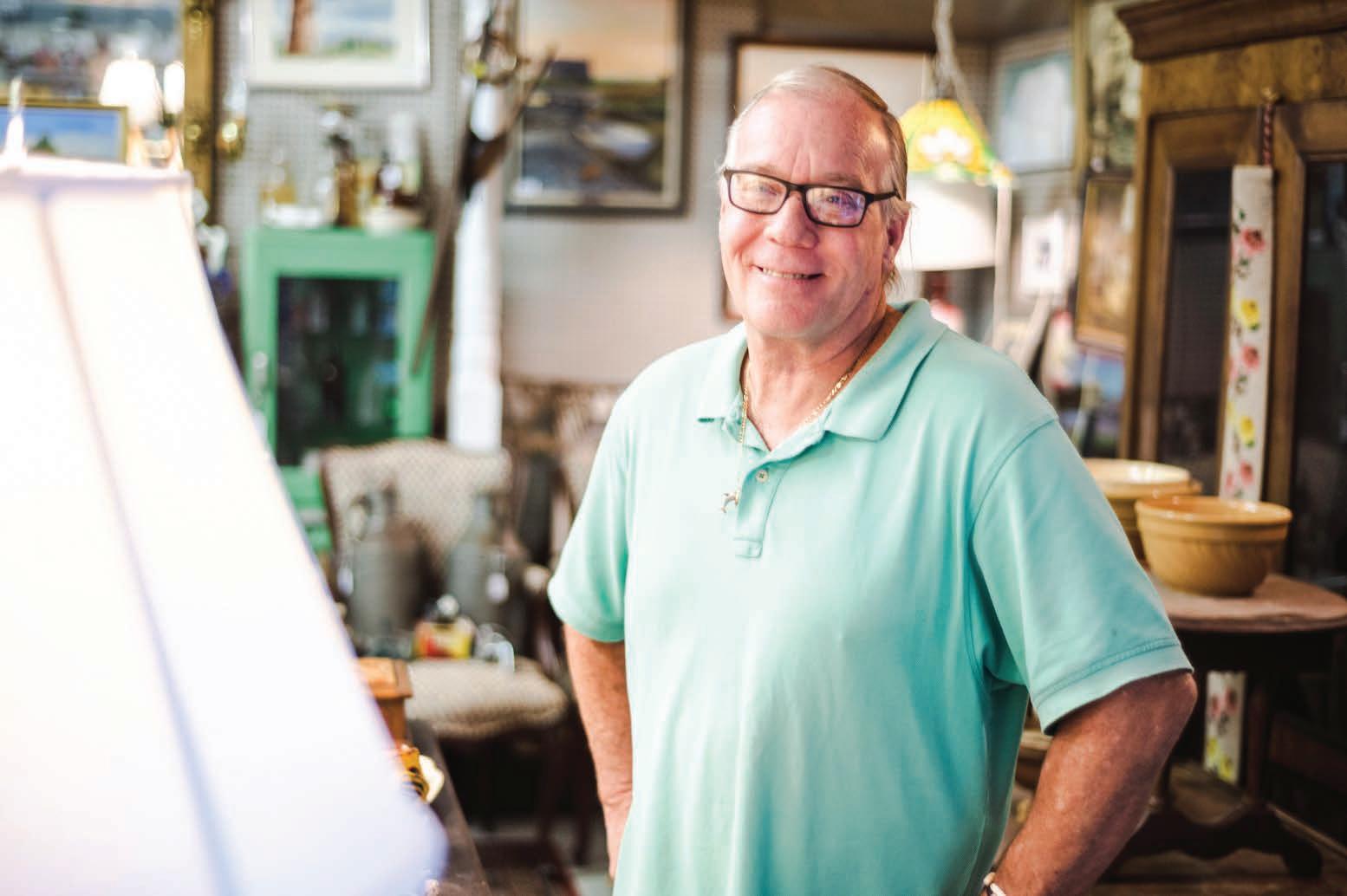
“We’re very fortunate,” said John of antiques on the Vineyard. “Lots of Island
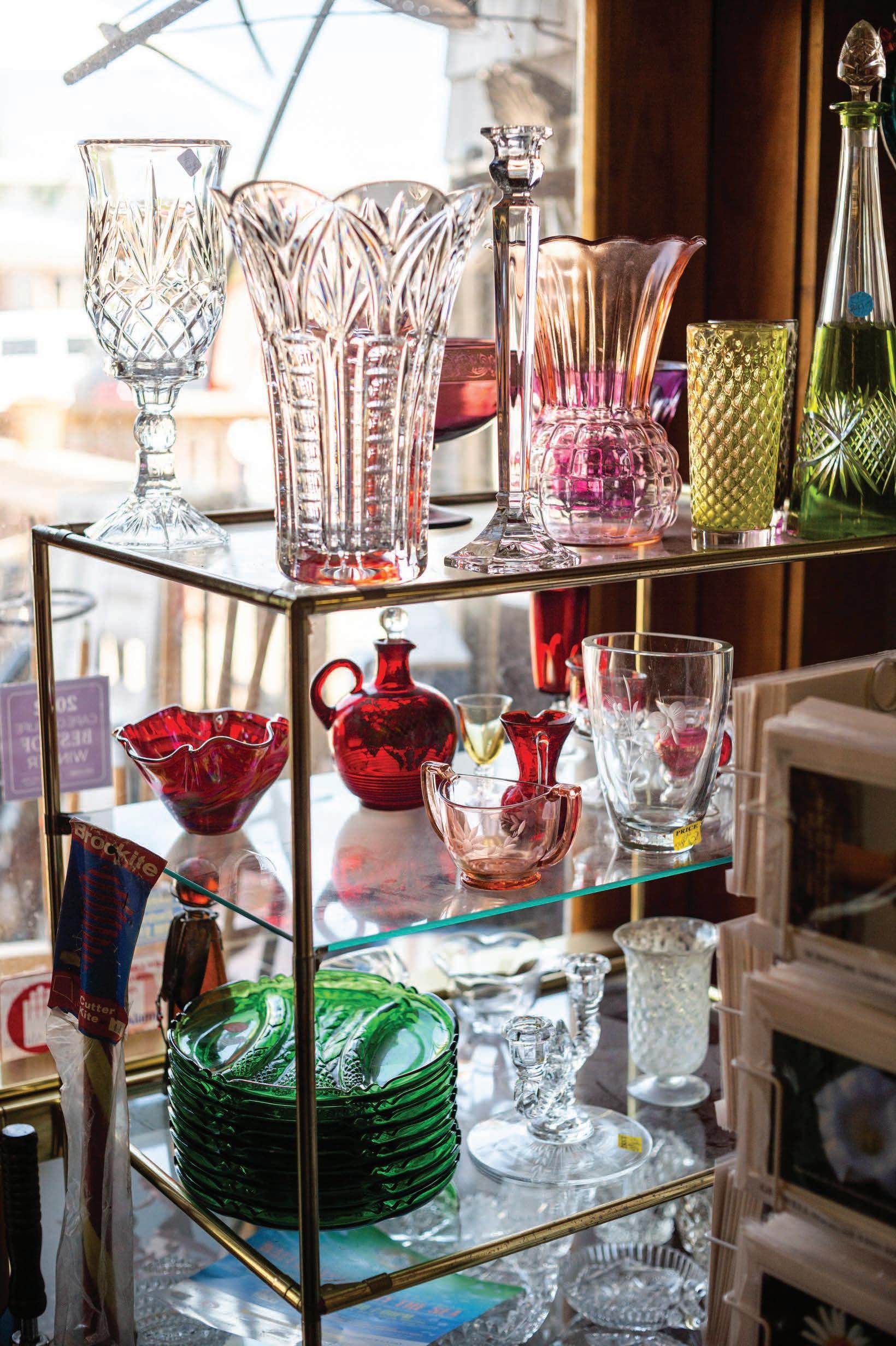
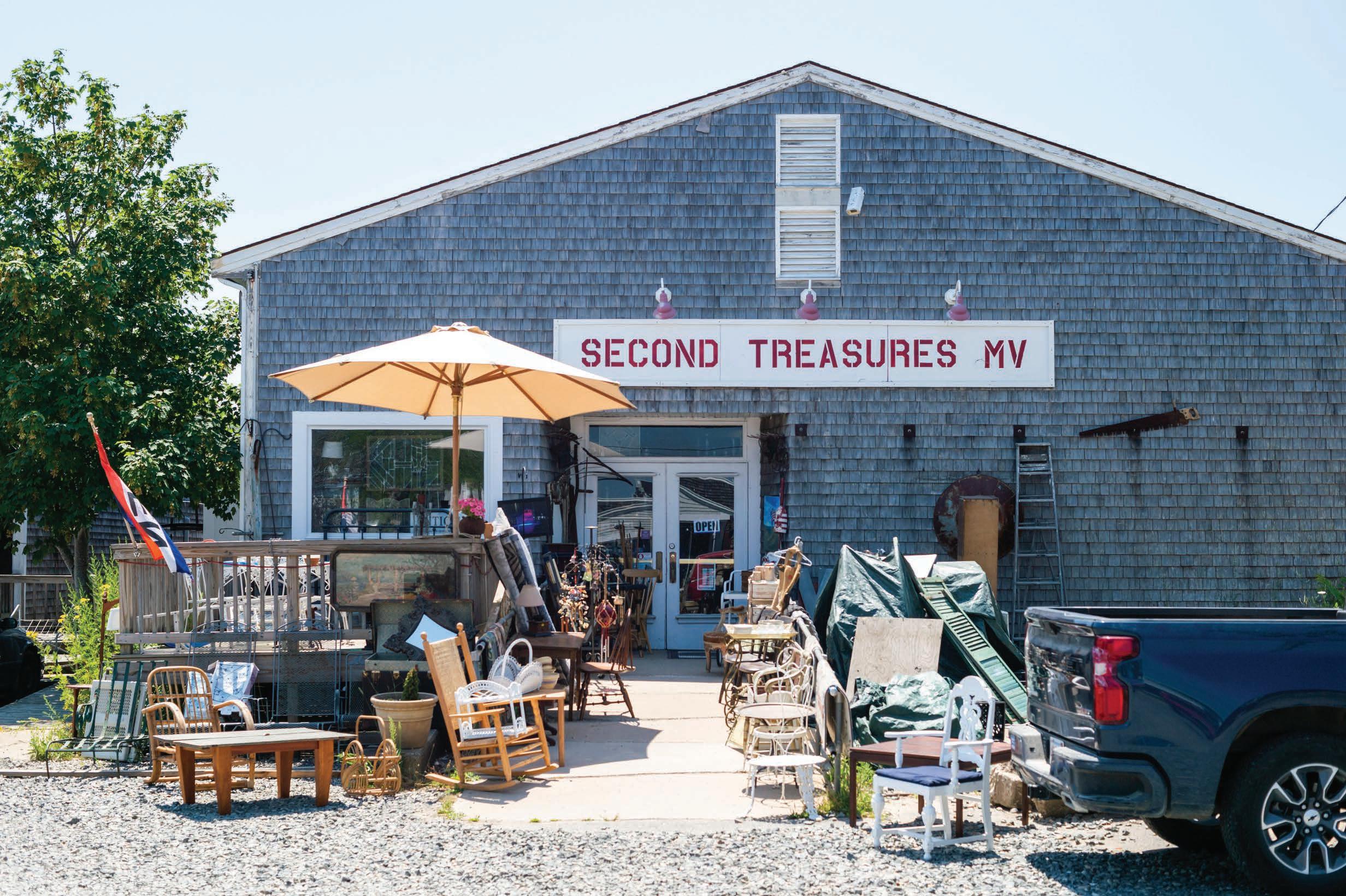
characters bring us all kinds of stuff.”
John manages estates for families onand off-Island, allowing him to display a range of inventory, from folkish farm implements to 15th century Russian icons, from mid-century furniture to dis tressed metal fittings. On his walls hang the works of Island artists such as Jean Spencer, who lived in the Pink House in the Oak Bluffs Camp Ground and contro versially cut out part of a wall to let in light for painting. John doubts that Jean
Page 14 · THE VINE
Second Treasures MV owner John Robert Hill (top right) is constantly shifting his store’s antique lineup. On sunny days, an array of new furniture and art will often appear on the ramp leading up to his store (top left), located on Beach Road in Vineyard Haven.
would approve of the house’s current shade of pink were she alive today.
The cottage style, though, goes fur ther than houses and paintings, as Patty Kirwin at Able to Cane Antiques will tell you. “I probably have the largest collec tion of bureaus on the Island,” she says.
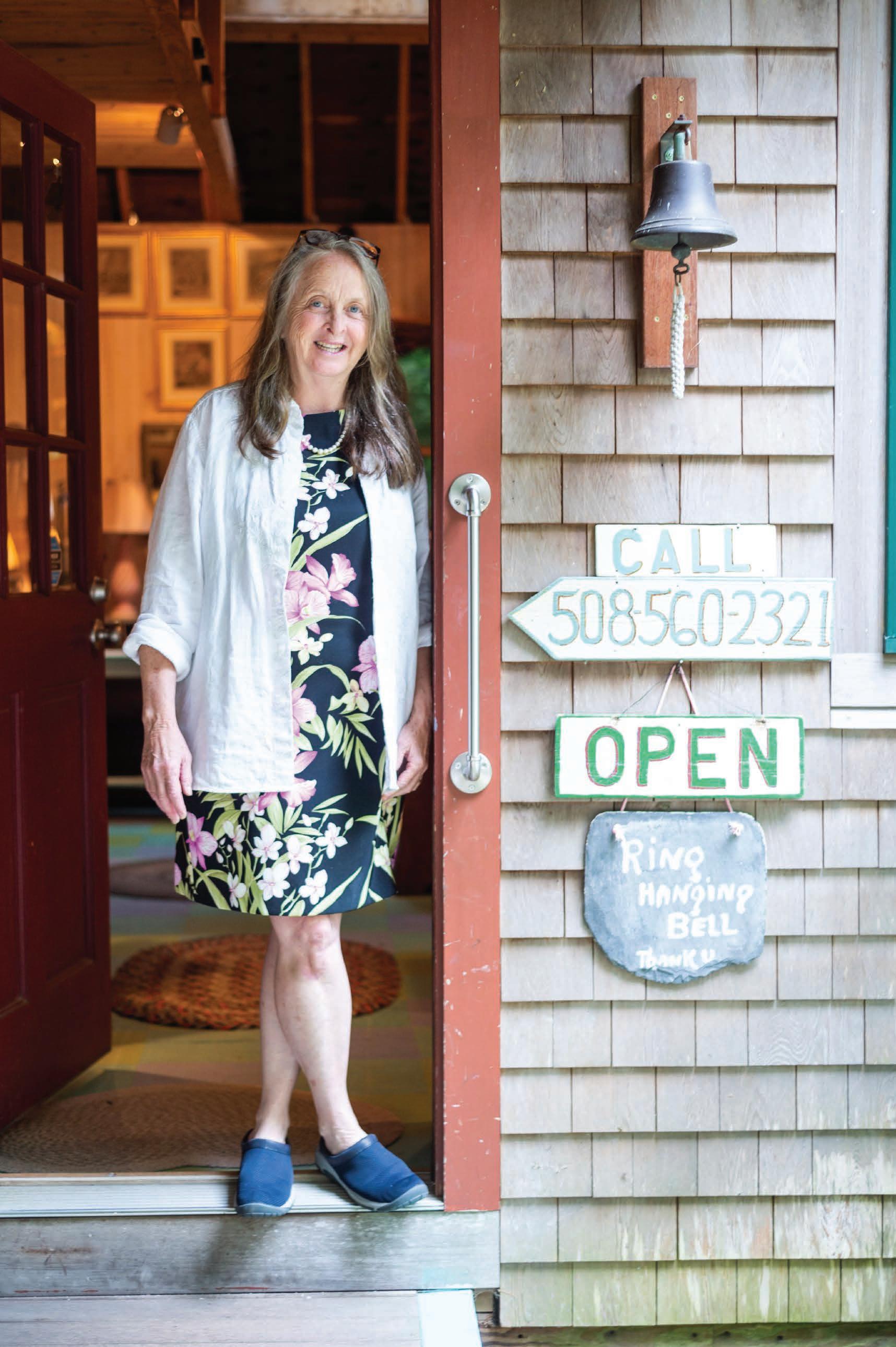
Patty appreciates the hand-painted oak and pine furniture favored in Camp Ground cottages, and she showcases a rotating selection in her cozy store, nestled in the woods of West Tisbury. She used to sell her wares at the Grange Exchange (the weekly West Tisbury an tique show) until the furniture became too heavy for her to haul.
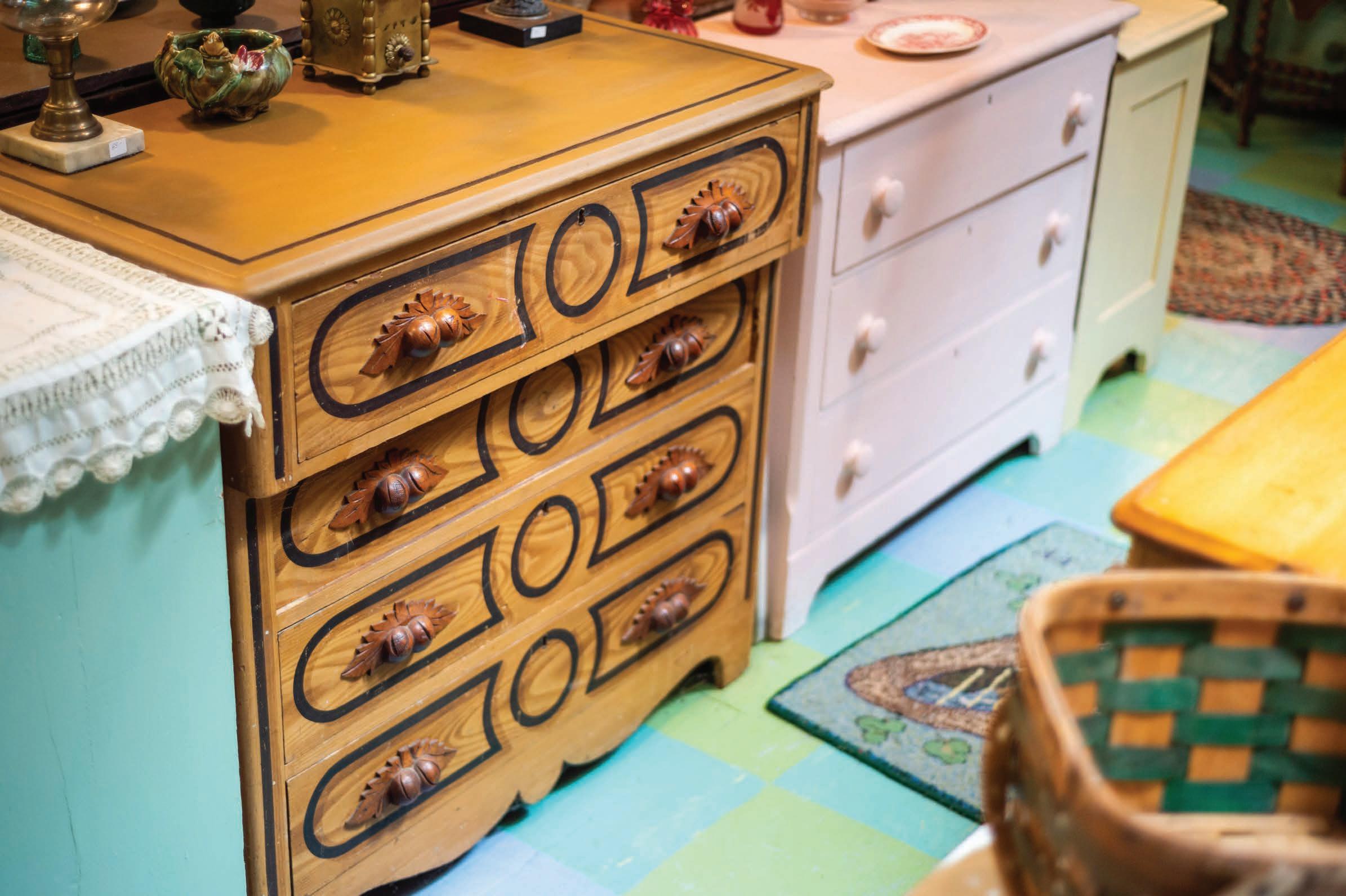
“I want to be antique but practical,” she said of her style.
To her mix, she also adds doorstops,
Sandwich glass and wicker chairs – all appropriate for a cottage look. If an item lasts too long in her shop, she says, she might paint a fish on it, as she often does to oars discarded by local boatsmen.
“These items always sell well,” said Patty, “Visitors love to bring home some thing from the ocean.”
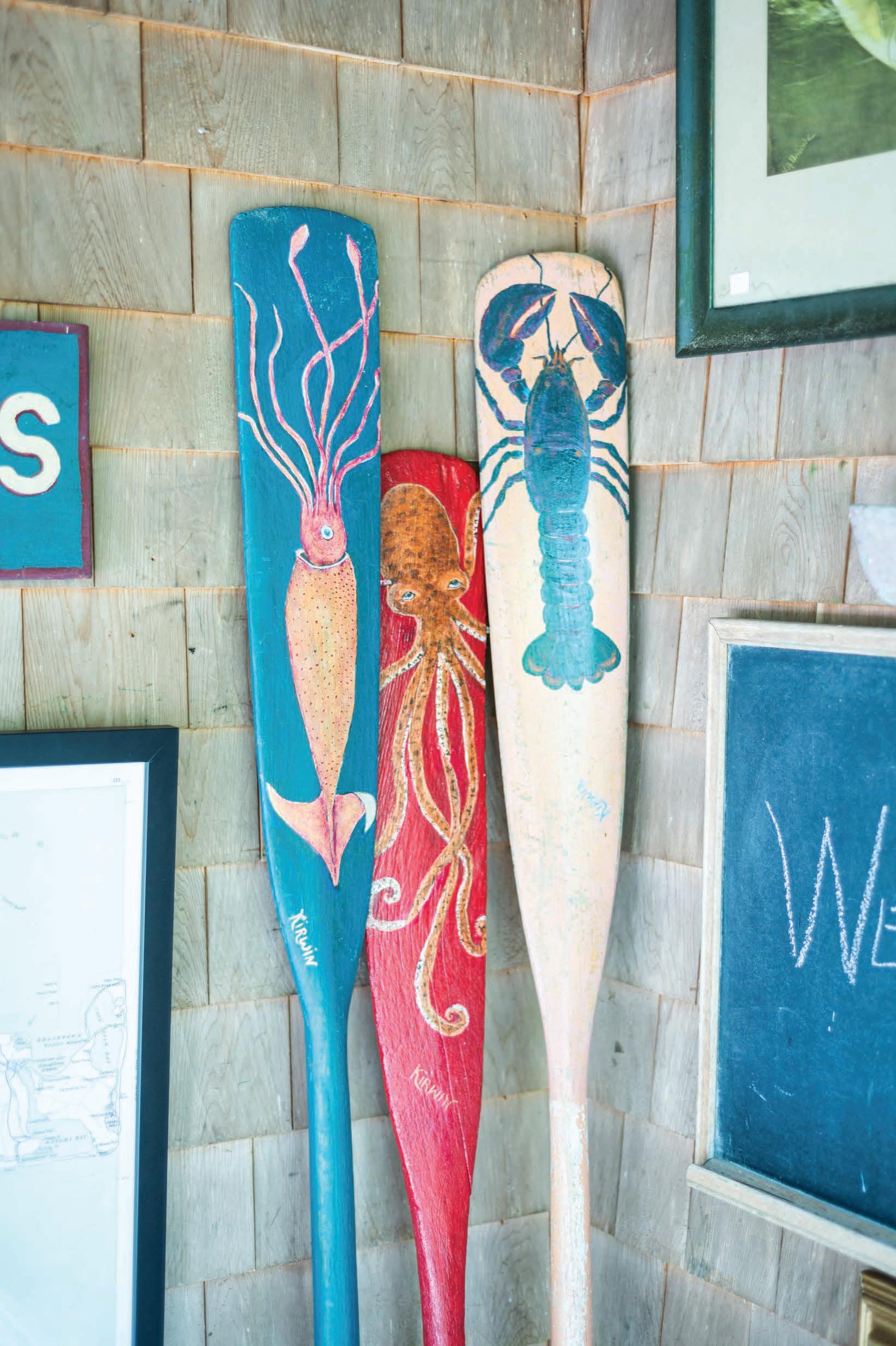
Tuckernuck Antiques on Tuckernuck avenue in Oak Bluffs is also steeped in Island history, though items there tend to originate on dry land. “I like to buy bits of Island historical stuff,” said Abby Armstrong, who opened the shop in 1995. If you walk in the store on Friday or Saturday – the only two days it’s open – you’re likely to find Abby constructing grand sculptures out of her extensive matchbook collection.

THE VINE · Page 15
Able to Cane’s Patty Kirwin is known for her large selection of cottage-style bureaus and other items you might find in an Oak Bluffs Camp Ground cottage – though her store is located in West Tisbury. She also displays her own hand-painted items, which often have a beach or nautical theme.
Island antiquarians will find that Tuckernuck boasts an impressive selec tion of Vineyard historical ephemera: old Vineyard Gazettes, books on Island his tory, survey maps, pamphlets and a near complete collection of the The Dukes County Intelligencer (a publication of the Martha’s Vineyard Museum). Lucky shoppers might encounter Dennis Rose, Abby’s picker, with his truck loaded up with forgotten or unwanted furniture from his trips around the Island. After more than a decade of searching, Dennis has developed a keen eye for picking out diamonds in the rough.
The up-Island village of Menemsha is a hotspot for Island antiquing. In ad dition to fine metalwork and paintings, The Copperworks of Martha’s Vineyard, owned by Scott McDowell and Annette Cingle, has an assortment of nautical antiques and artifacts. Danish eel spears and old whaling harpoons line the walls, and a display case shows off a substantial collection of antique lures and tackle.
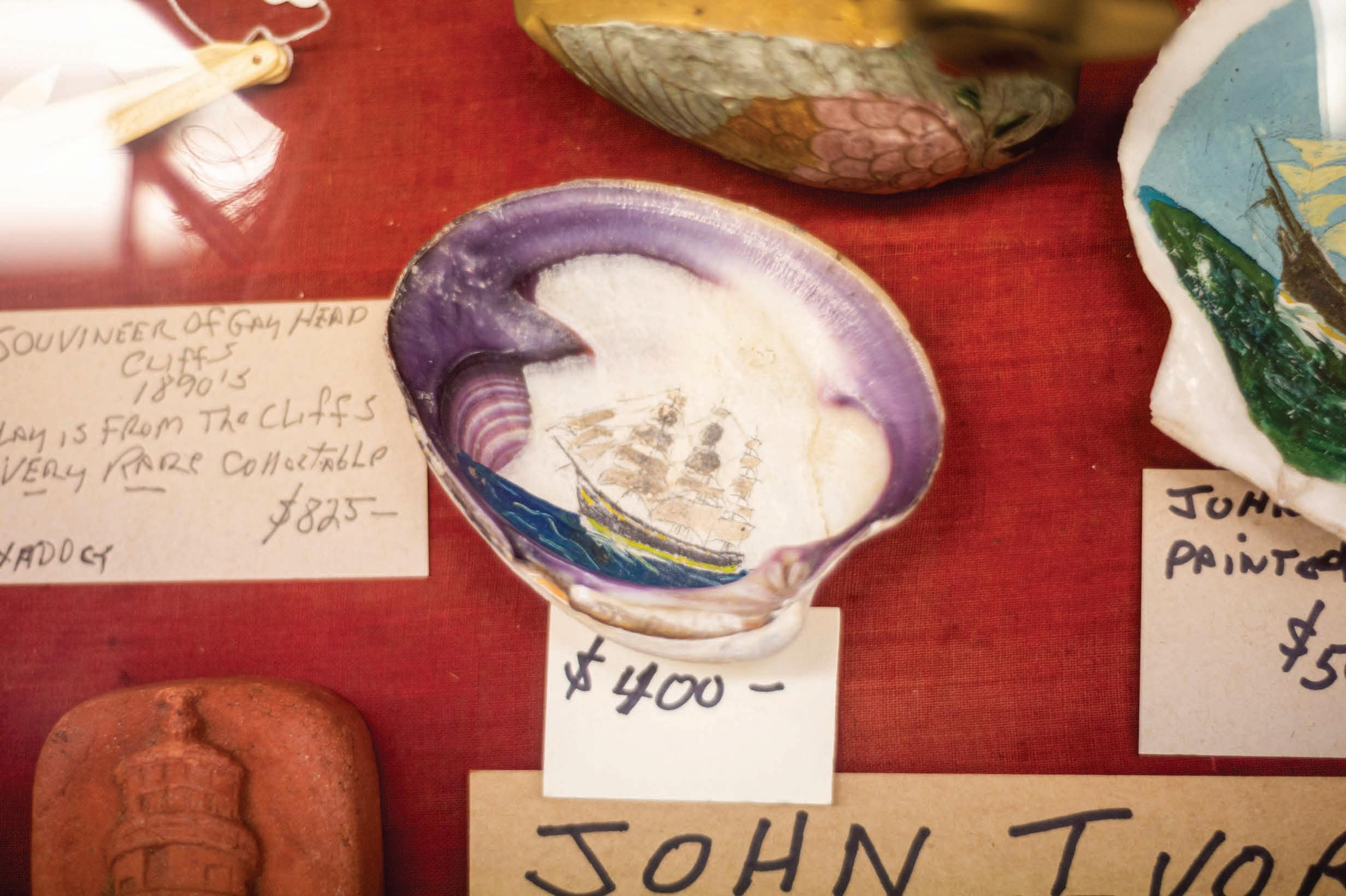
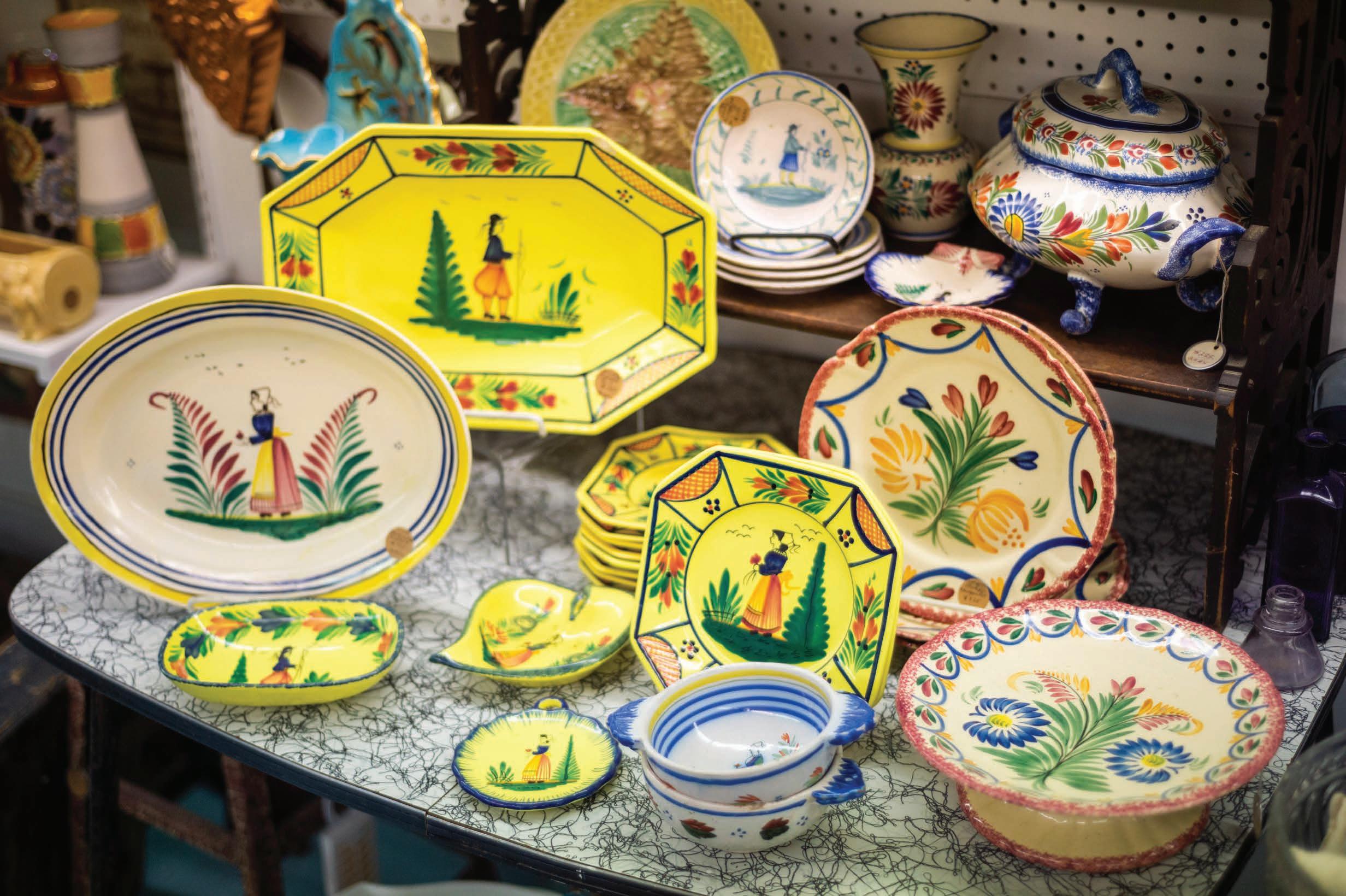
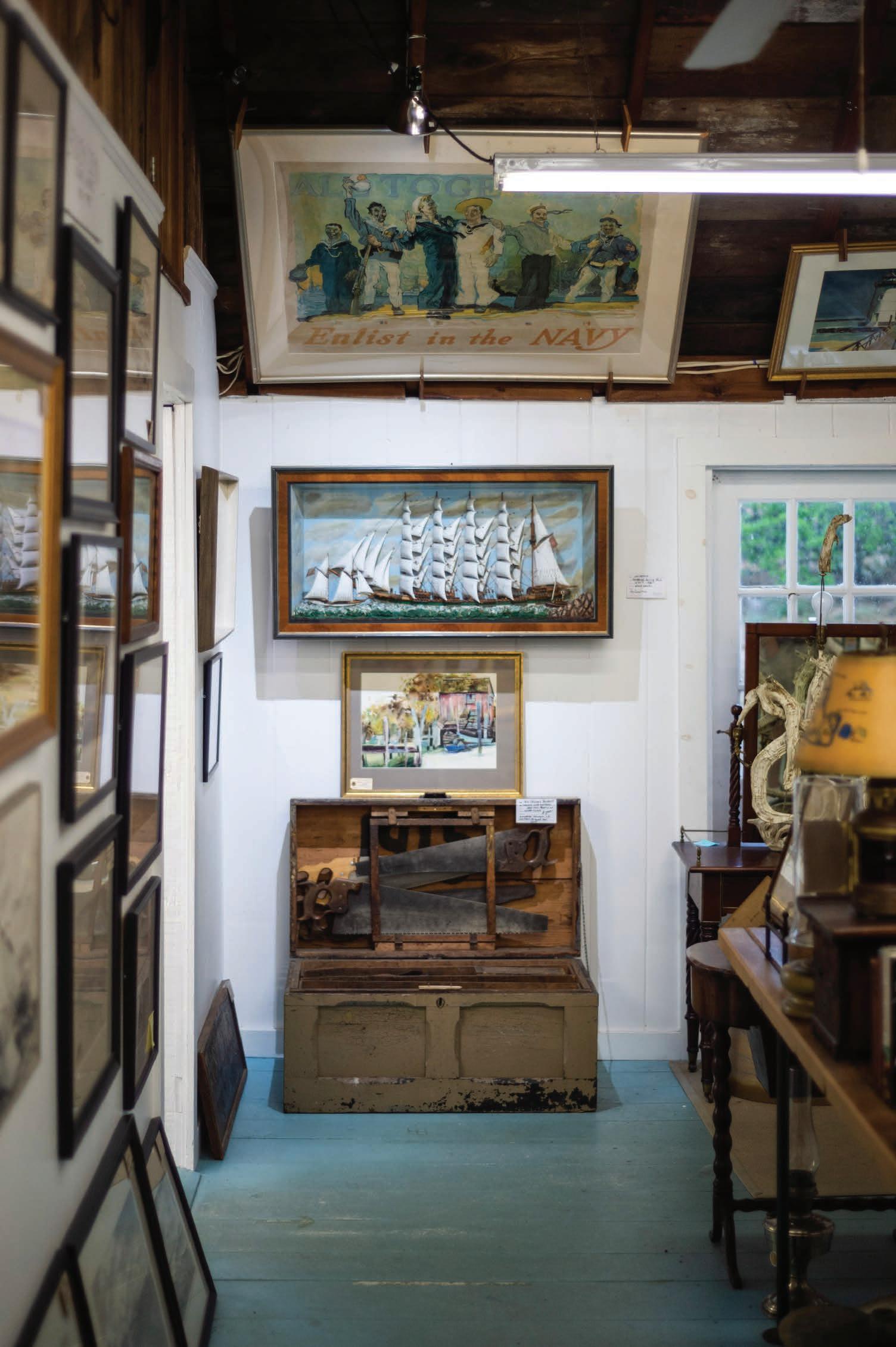
Creekville Art and Antiques, down the road from The Copperworks, has the most up-Island flavor of any Island an tique shop. The location has a long his tory, run for more than 40 years by Jane Slater, former town columnist for the Vineyard Gazette, before it was turned over to its current owner, Doug Seward.
“I came in one day to look at a piece Jane had up on the wall, a piece of the window from the City of Columbus shipwreck up there at Gay Head,” said Doug, recalling how he came to run the store. “I had to wait all summer for it; she wouldn’t bring the price down!”
“So, I sat there every Saturday, and eventually she said, ‘I’m quitin’ the store next year and the year after, you’ll come in here.’”
Creekville is split into two rooms. The one on the right is mostly managed by Doug’s partner, Suzie Pacheco and is stocked with shelves of glass and china, alongside her own paintings. To the left
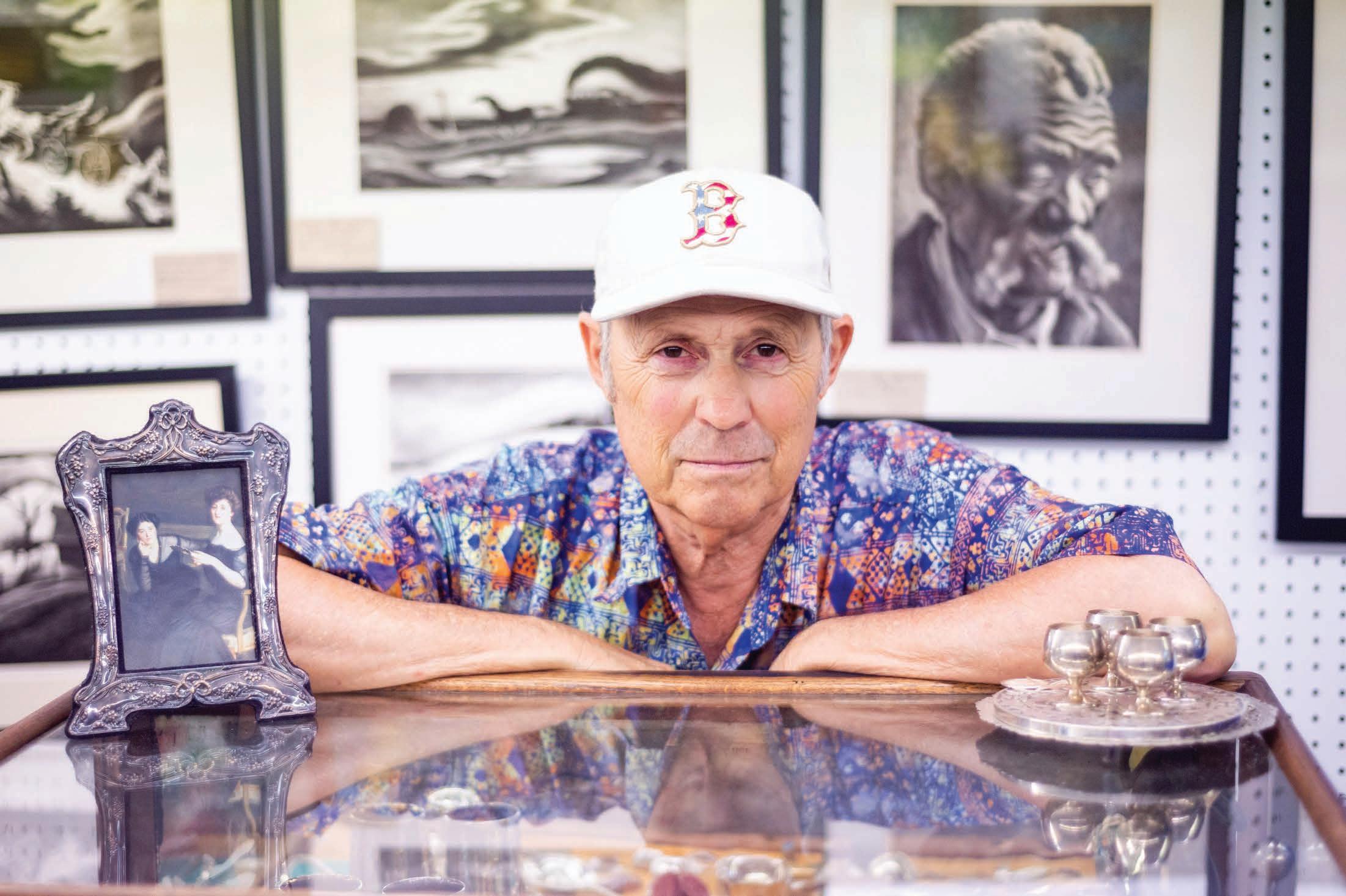
Page 16 · THE VINE
Doug Seward (top), a prolific Island collector, now operates Creekville Art and Antiques in Menemsha with his partner, artist Suzie Pacheco. Suzie curates a selection of ceramics and glassware, while Doug’s art includes Thomas Hart Benton lithographs and one-of-akind works from lesser-known Island artists like mariner John Ivory (painted shell above).
is Doug’s zone (though there is of course some overlap). Every inch of wall is hung with works by Vineyard artists, along with every painter who ever stopped on the Island to capture the Gay Head Cliffs.
In a glass case below lithographs from storied artists like Thomas Hart Benton and Adolf Dehn – both artists who were part of the Regionalist movement and spent summers on the Island – lie works from a humbler artist and boatsman: John Ivory. “He was a master mariner,” said Doug. Ivory had circumnavigated the world several times before living in his iconic Vineyard Haven boathouse.
“He painted on anything he could find, shells or the back of roof shingles, and he became quite famous locally,” Doug said.
If not for a few dedicated local collectors like Jane and Doug, his work might be all but forgotten today.
These shops are just a taste of what antiquing on the Island has to offer. (See list at right.) Rusted relics abound at Pyewacket’s in Vineyard Haven, while high-quality thrift stores are hotspots for vintage deals. Both the Grange Exchange and the seasonal Chilmark Flea have a rotating cast of antiquarians, each with their own specialization. Each place is worth a visit since antiquing is all about the hunt, about hearing an object’s story and, perhaps, adding your own chapter.
Thomas Humphrey is a reporter at the Vineyard Gazette.
Let's Go Antiquing
Tuckernuck Antiques
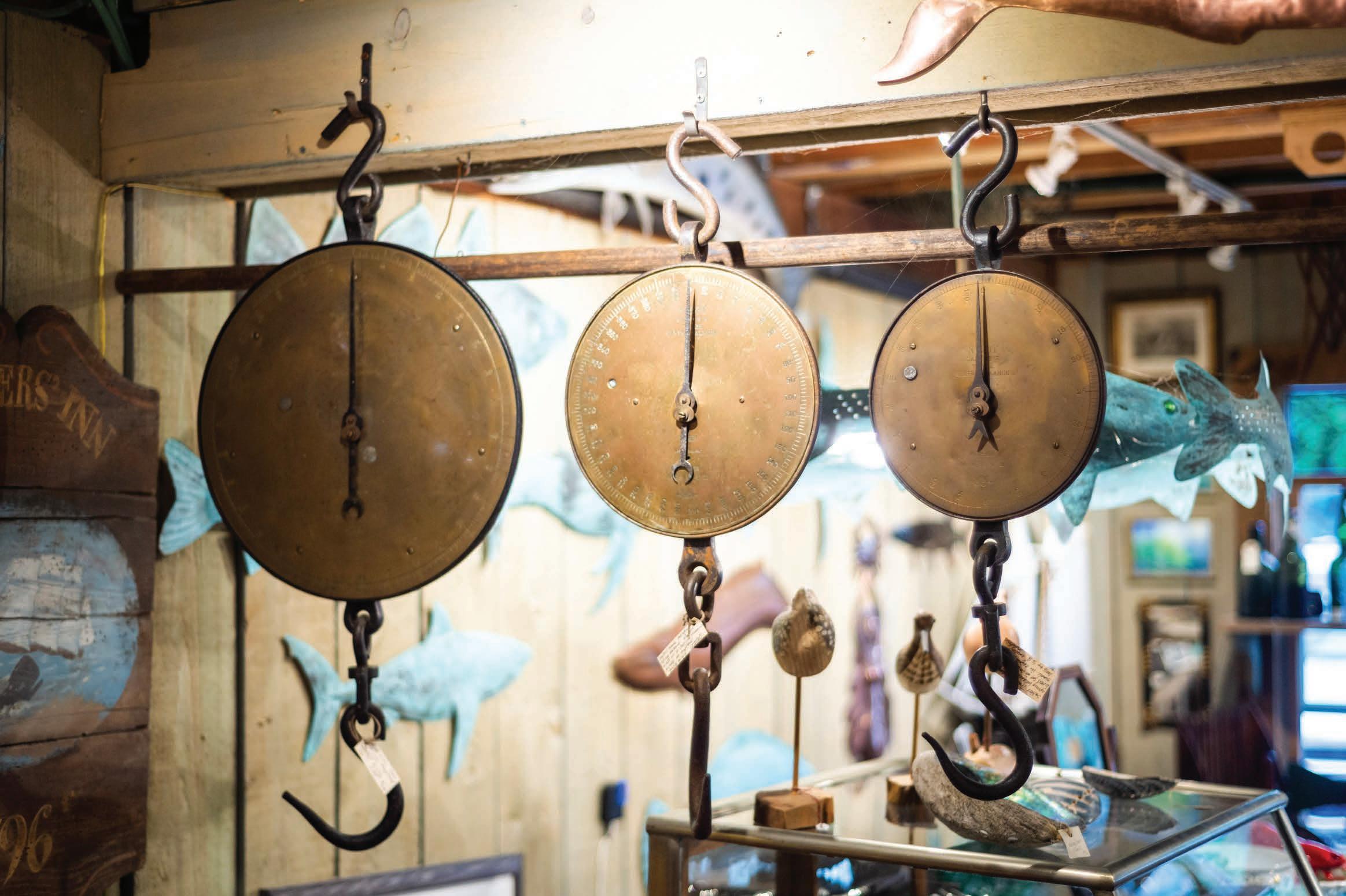
79 Tuckernuck avenue, Oak Bluffs
774-563-5340
11 a.m. to 4 p.m. Friday and Saturday.
Creekville Art and Antiques
8A Basin Road, Chilmark 774-563-8374
11 a.m. to 4 p.m. Monday–Saturday; 12 p.m. to 4 p.m. Sunday. Seasonal. Call for appointment off-season.
Second Treasures MV
61 Beach Road, Vineyard Haven 850-293-4345
10 a.m. to 5 p.m. Thursday-Saturday and Monday; 12 p.m. to 5 p.m. Sunday.
Able to Cane Antiques
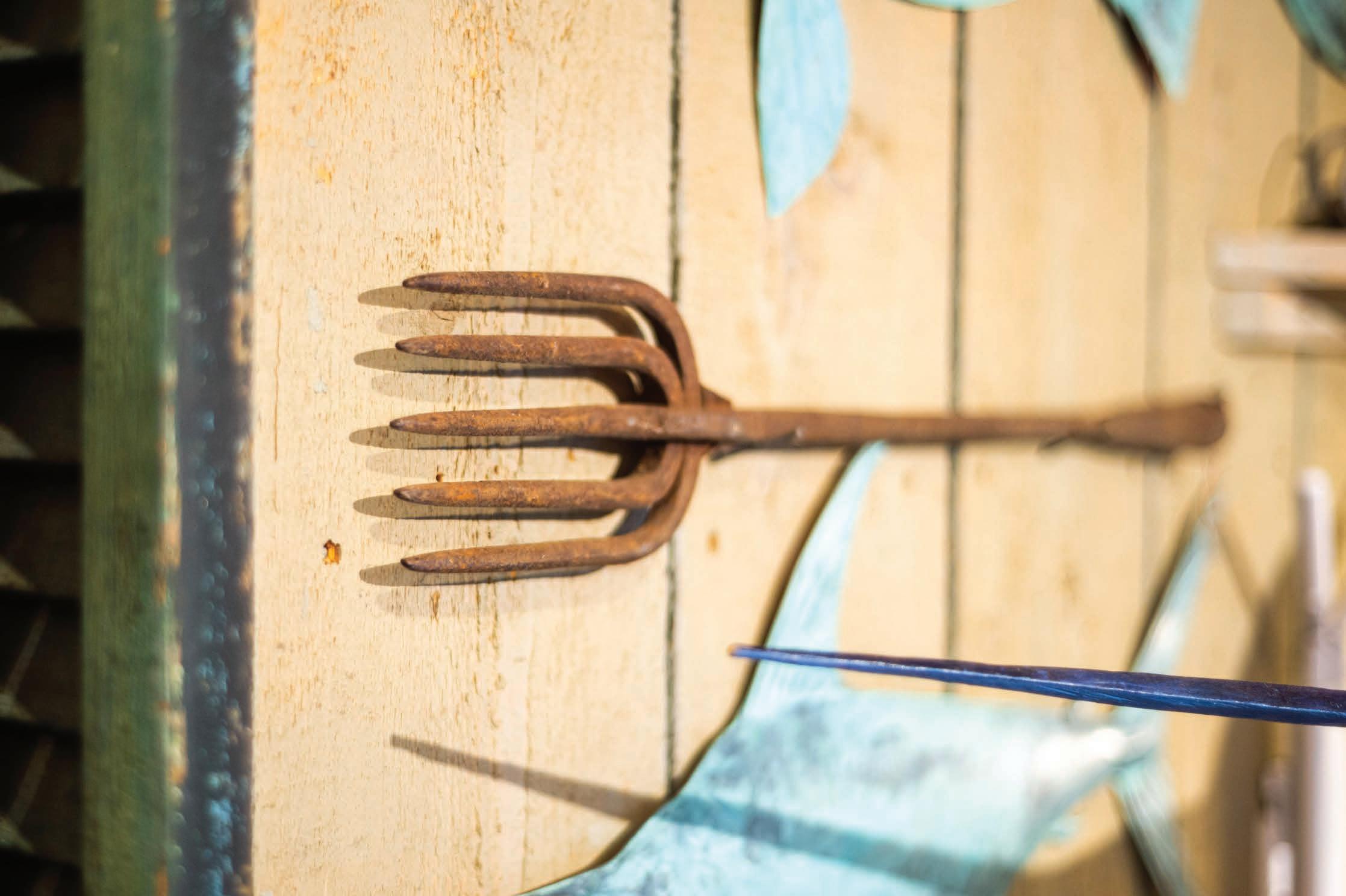
96 State Road, West Tisbury 508-560-2321
11 a.m. to 5 p.m. almost every day (call ahead to check)
Grange Exchange
The Grange Hall, 1067 State Road, Vineyard Haven 9 a.m. to 3 p.m. Friday. Seasonal.
Past and Presents
37 Main street, Edgartown 508-627-6686
Open: 11 a.m. to 5 p.m. daily.
Chicken Alley
38 Lagoon Pond Road, Vineyard Haven 508-693-2278
10 a.m. to 5 p.m Tuesday-Wednesday, Friday-Saturday; 10 a.m. to 7 p.m., Thursday.
Act Two Secondhand Store
66 Main street, Vineyard Haven 508-338-2124
9 a.m. to 4 p.m. Monday - Saturday.
Pyewacket’s
135 Beach Road, Vineyard Haven 508-696-7766
11 a.m. to 5 p.m. Tuesday-Sunday. Seasonal. Call for appointment off-season.
THE VINE · Page 17
Eel spears, harpoons, fish scales and other antiques reflecting the Island's seafaring histo ry are displayed alongside copper art and weathervanes at The Copperworks of Martha's Vineyard in Menemsha.
Making Room for Babies
Photographer Maria Thibodeau knew what she wanted in a home studio: lots of light, room for her props – including her crafted felt wool – and a calm, peaceful environment.

 BY JANET NEWTON • PHOTOS BY JEANNA SHEPARD
BY JANET NEWTON • PHOTOS BY JEANNA SHEPARD
While Island native Maria Thibodeau makes her primary living as a high school English teacher, she pours her creative energies into a thriving side business as a photographer – with a particular pas sion for birth and newborn photography.

Over the last few years, as Maria scheduled more and more baby shoots, she came to realize that photographing babies – unlike families, where beautiful Vineyard backgrounds do the trick — requires props and light and warmth and backdrops and wraps. It also requires a way to organize and store all of those tools of the trade.
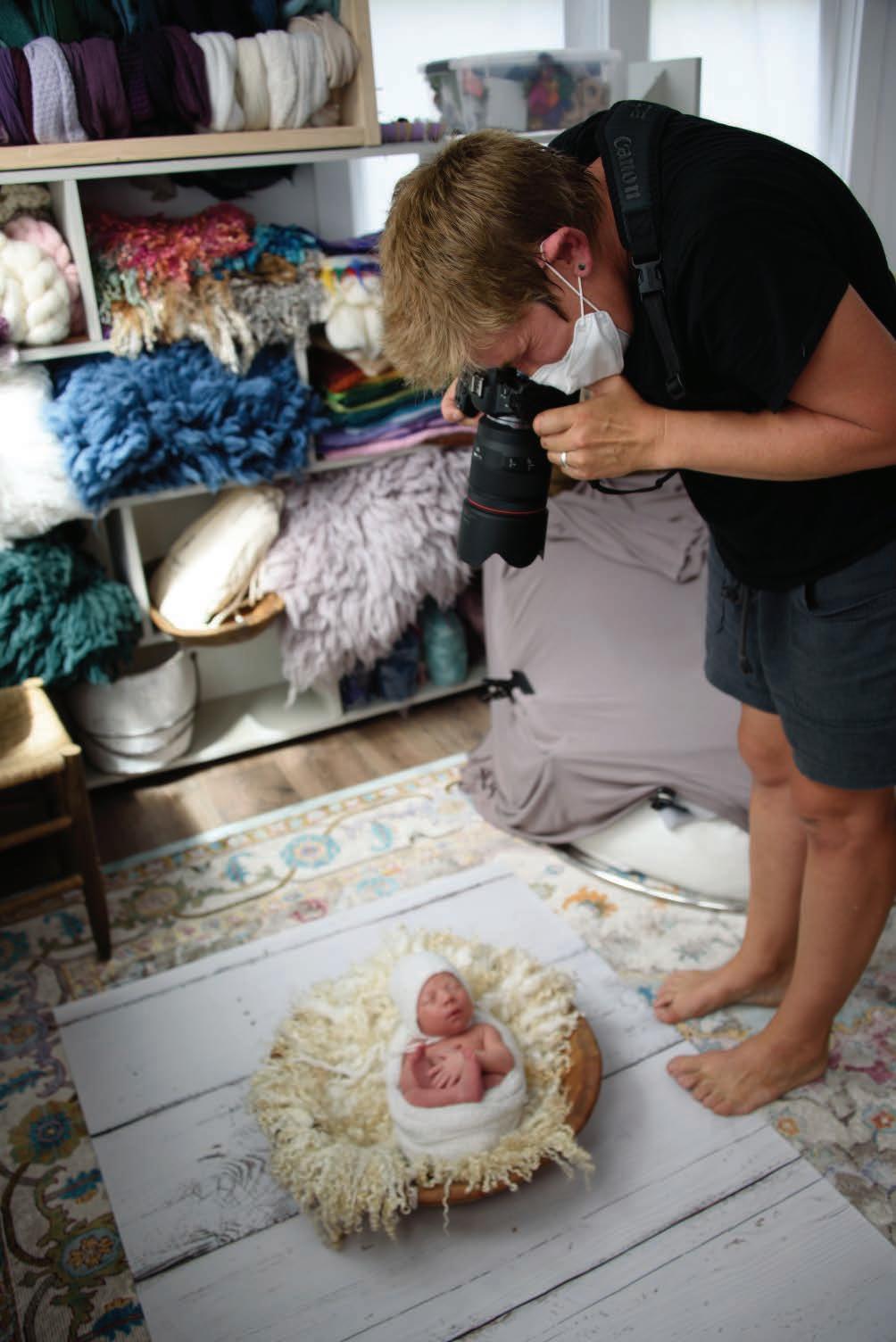
At first she didn’t have a space of her own. “For a long time I would go to people’s houses and schlep all my ac cessories around and try to find a space in their house that had the most light or the best windows,” she shared in a recent Vine interview. Sometimes she was forced to adapt to dark spaces, and sometimes she got lucky, encountering “phenomenal spaces with floor to ceiling windows.”
Shooting in so many different spac es helped Maria think about what she would want in a studio of her own. “I knew I would need good light — lots
of windows,” she said. “But I would also need it to feel calm and peaceful and organized. Generating a sense of peace helps with my newborn sessions be cause babies feel our energy. So if I’m anxious or stressed out it affects the shoot. I need to be in a calm, slow and patient space.”
As it happened, before Maria finalized her own studio in Edgartown, she had a chance to try out her thoughts when she and her wife and two children spent a year off-Island, living in central Massa chusetts in a house that had a big room off the garage, which Maria worked to
transform into a studio.
She also used that opportunity to figure out how best to organize all the “tools and textures and bits and pieces” she uses for her work. “It was the first time I could have everything out and ac cessible instead of being stored in bins ready to be carted from house to car to house and back again. It helped me to see that I took inspiration from seeing all the colors and textures out on display.
"Part of my creative process is think ing about what might work best for any given baby, based on the parents’ ex pressed preferences, but also on my style
Page 18 · THE VINE
CREATIVE SPACES PHOTO STUDIO
and intuition for what fits a particular baby,” she added.

While Maria loves the studio she has now, she acknowledges that it has its shortcomings size being one of them. “When I first started thinking about a studio, I pictured it as a separate ac cessory building, and I fantasized about how big it could be and what it would be like to build a greenhouse of windows as an outbuilding, with at least 10-foot ceil ings always taller!” she said.
But the more she looked into it, the more it became clear that her vision was a financial impossibility on the Island. “Living in my family’s ancestral home and trying to make it work for my needs in the 21st century was always the chal lenge,” she said. “I have sentimental at tachment to a house I’m grateful to have, even though it is less than ideal for cre ative pursuits, especially with a family.
So I knew I’d need an ‘outside this house’ space, even though I didn’t know what it would look like or how I would be able to make it happen.”
Eventually Maria decided the best op tion was to build a garage/studio combo. Even making that happen “involved a lot of forward and back. I think of it like climbing a hill using switchbacks. You are getting somewhere but you have to go back and forth to achieve every inch of elevation,” she said.
When asked how she feels about her studio, Maria gleamed: “I love it. I just love it. It’s my happy place. I like putting my toddler on my back and just going and puttering in there. Walking in the door I feel contentment and peace.”
Janet Newton is minister of the Unitarian Universalist Church in Vineyard Haven and Maria Thibodeau's wife.
Felted Wool for the Win

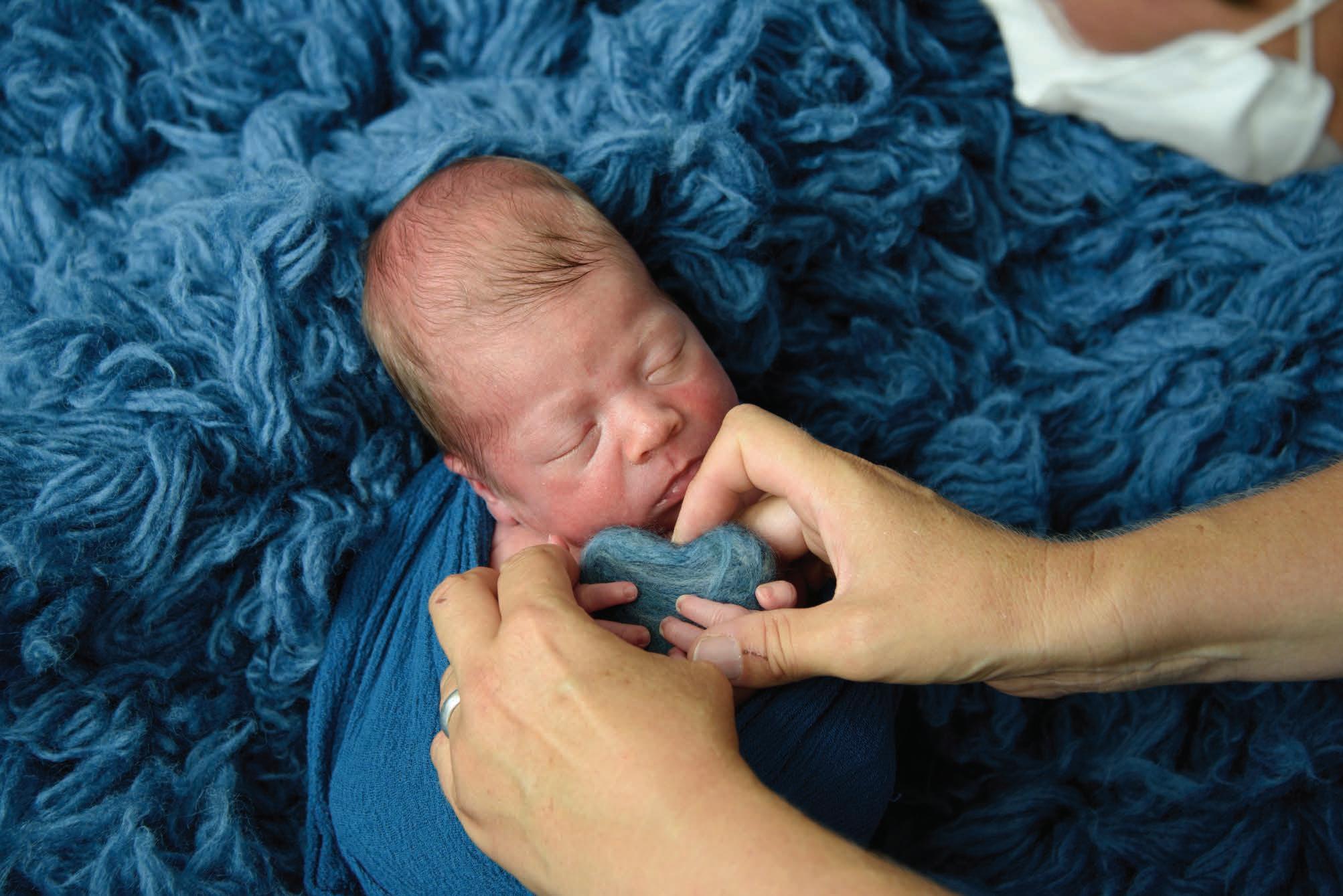
Maria Thibodeau often draws on the local environment for her work – ocean colors and farm and field and beach textures. This incli nation drew her to try her hand at creating felted background tex tures of her own. She started with needle felting because her wife already had tools for that laying around, but she quickly discovered that wet felting worked better for larger pieces. Both needle felting and wet felting are ways to agitate wool fibers so that they bond together. Maria loves the way felting combines color and texture in a way that milled fabric can’t. Her efforts have helped produce just the right feeling for certain shoots. “I had one person who wanted a Martha’s Vineyard farm vibe,” she said, “so I used some roving I’d gotten from a sheep at Morning Glory Farm and wet felted it into a textured background.”
The creation of her own props – including the felted heart in the pho tos above – comes partly out of a DIY aesthetic. “I’ll look at some thing that someone else has done and think, ‘I bet I could make it myself for cheaper.’” But her initial forays into that world held some hard lessons. “When I started, I had no idea how big a pound of wool was; it was an abstract measurement to me. So I would order four pounds of fleece with visions of four pounds of apples in my head, and then a huge tote of wool would show up at the post office!”
These days, Maria knows her way around wool – and the capacities of her studio space. There’s only so much room in the boat!
THE VINE · Page 19
For photographer Maria Thibodeau, having a designated, light-filled studio to photograph babies means not only that she doesn't have to haul her props and handmade crafts around, but also that she has a space that generates a calm and peaceful energy.
CREATIVE SPACES
Maria Thibodeau
What’s All The Hoopla About Hoop Houses?
A low-tech alternative to an expensive green house, a hoop house can add months to your growing season – and boost your summer bounty.
BY THOMAS HUMPHREY • PHOTOS BY RAY EWING
As the warmth of summer fades, so too does your garden’s bounty, winding up with a last autumnal burst of squash and beans. But your late season garden need not be so limited, nor should spring be just for planting. Enter the hoop house, a microclimatic sanctuary from the changing of the seasons. If managed cor rectly, this low-tech proto-greenhouse can turn your fall, spring and sometimes even winter gardens into veritable cor nucopias of backyard produce.
The structure of a hoop house is em inently simple: a series of metal or PVC poles, arched and secured to the ground or to a wooden base, covered tightly with a semi-transparent plastic film, and out fitted with a door (or two) on one end or both. The structure holds in heat, creat
ing a microclimate in which plants can be grown outside their normal seasons.
A hoop house is not a greenhouse, but the distinction between these can be confusing. The defining characteristic of a hoop house, also called a high tunnel on a farm, is its inherently low-tech con struction and its iconic half-moon shape reminiscent of a Quonset hut.
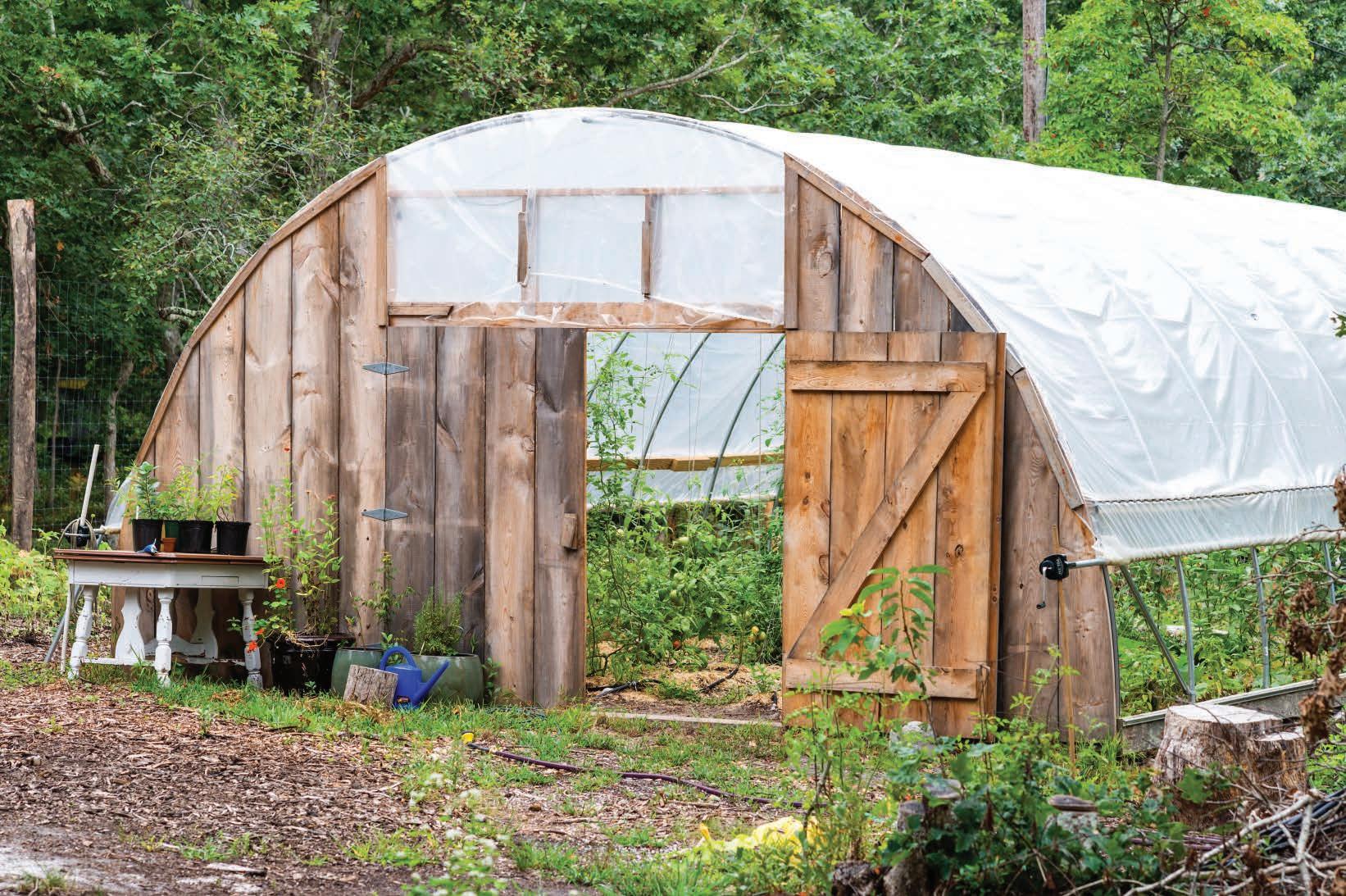
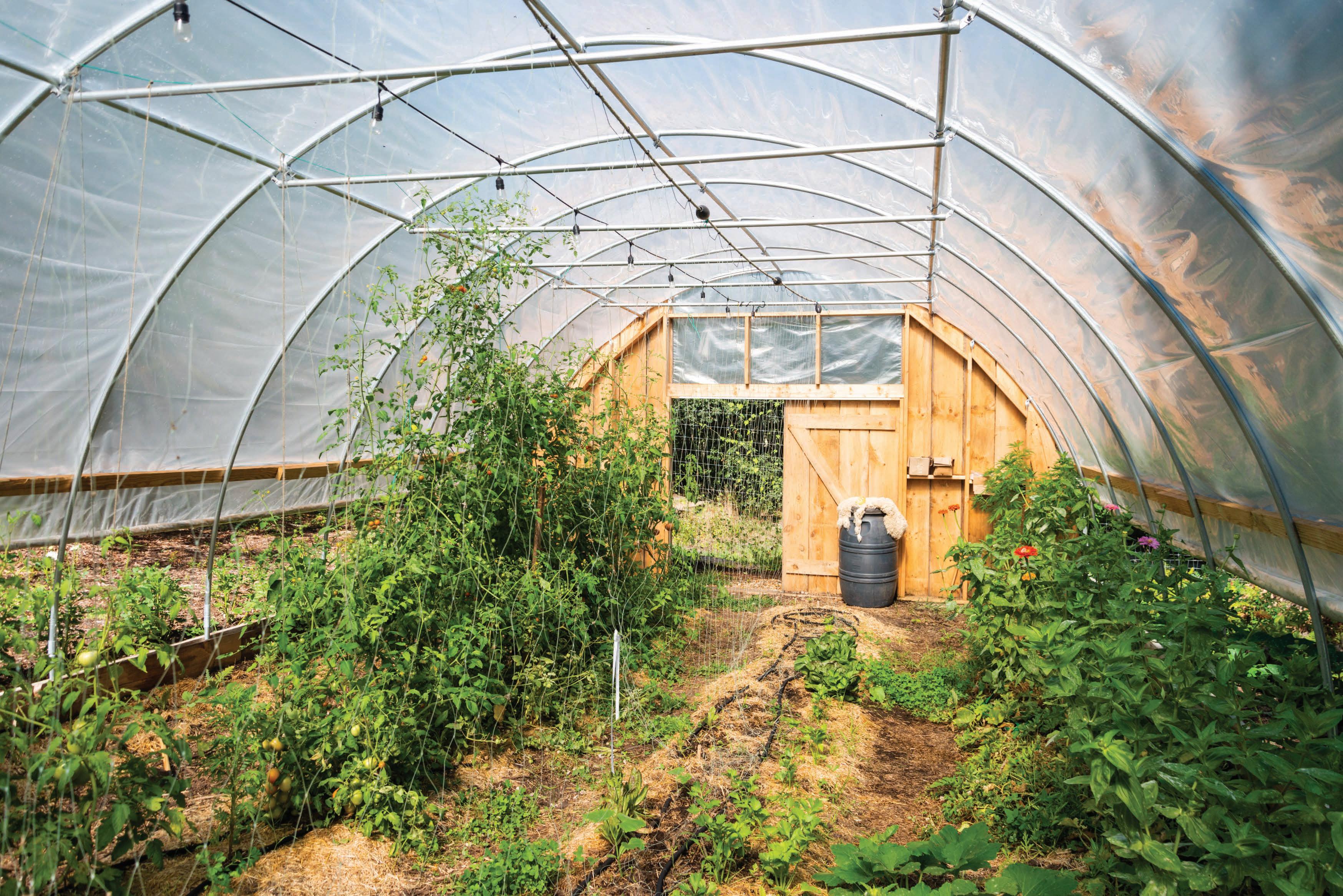
A greenhouse, on the other hand, is more complex, often made of solid plas tic or glass panels, often temperature controlled, and usually more houseshaped, with a pitched or angled roof. Notably, a greenhouse is more labor intensive and expensive to erect than a hoop house and is intended to last far longer.
But though a hoop house is easier to erect than a greenhouse, it’s still a big un dertaking, notes Heidi Feldman, an avid gardener and proud hoop house owner. The first one that she and her husband Curtis built “was a disaster,” she recalls. “It collapsed under the weight of the heavy snowfall that year.”
Round two, however, was a smashing success and the 16’ x 20’ hoop house still stands tall on their West Tisbury prop erty today. The pieces were acquired through a barter with another Island gar dener. (Heidi doesn’t remember the ex act transaction, but suspects it involved a few vegetables). Aside from the occa sional tear from a strong gust of wind, no major problems have occurred since the first collapse. The couple, co-owners of
MV Sea Salt, have gone on to build much larger hoop structures to house and de hydrate their sea salt.
Marie Larsen, a retired school admin istrator who took up vegetable gardening to become more self-sufficient, has yet to have any structural issues with her hoop house. Hers is smaller than Heidi’s; a center beam adds extra support and the ends of her hoop house are wood en arches. The most important factor Marie considered when planning her hoop house was location; she chose a protected spot in her Chilmark yard that wouldn’t be exposed to much wind.
Lynne Irons, Marie’s gardening men tor and Vineyard Gazette garden colum nist, agrees that wind is the primary foe of hoop houses. “My son and I have an
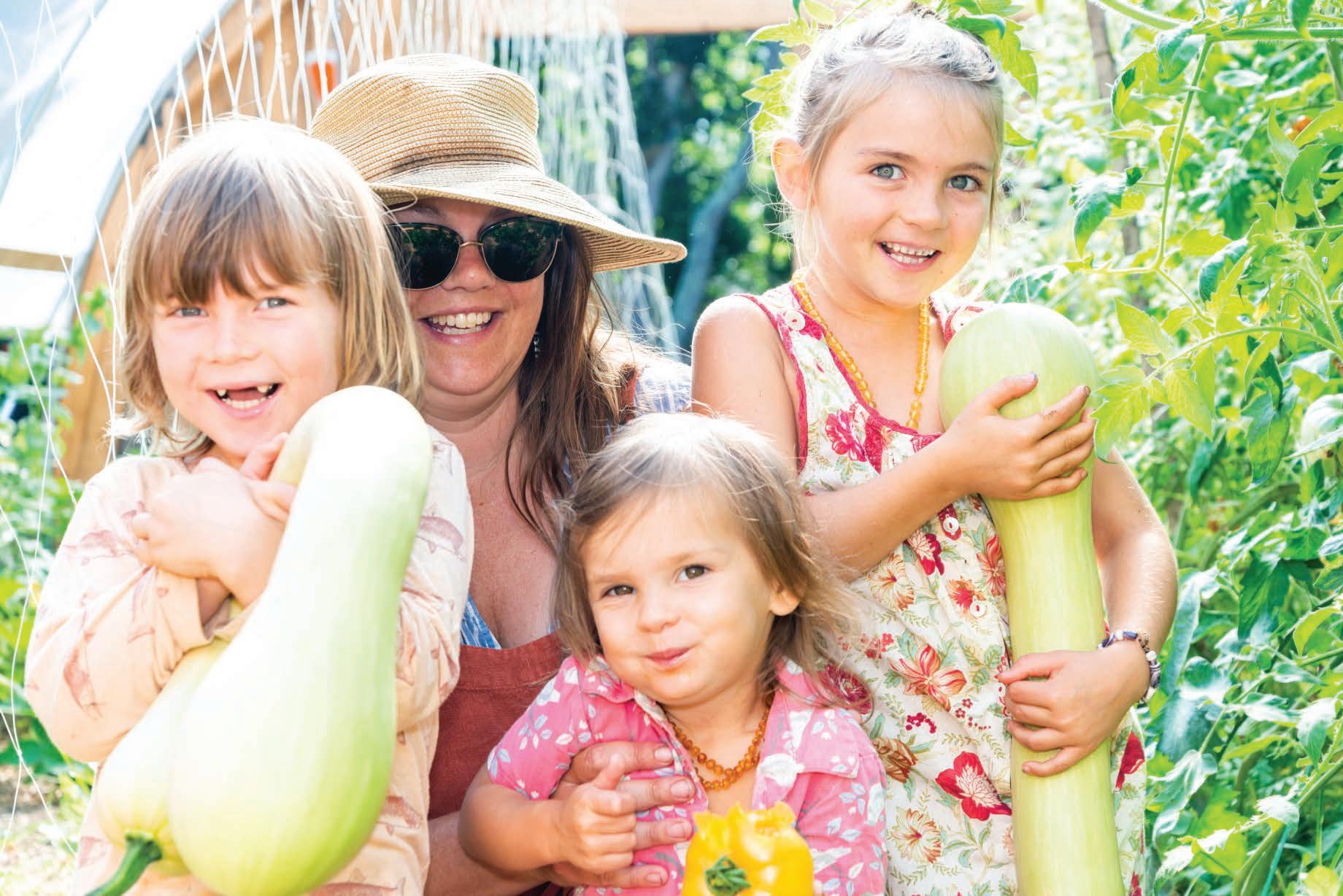
Page 20 · THE VINE
Niko and Rachael Ewing (with Silas, Maizey, and Mirabai Ewing at right) are serious homesteaders and built their 20' by 36' Edgartown hoop house to last, with cross beams for roof support. In addition to annual crops like cherry tomatoes, the structure also protects tender perennials like Rachael's pomegranate tree and lemon verbena.
ongoing argument about wind,” she says. “He says that if you leave the hoop house [doors] open, the wind will come in and lift it off. But I say if you leave them open, the wind is gonna knock it down.” She adds that if you build the hoop house in a protected area, wind won’t be an issue.
Rachael and Niko Ewing’s 20’ x 36’ behemoth in Edgartown requires more significant internal support. “Ours has crossbeams across the [interior of the] roof, which I highly recommend,” says Rachael, standing between her sevenplus-foot tall sun gold tomato plants. Their hoop house is constructed of both metal and wood elements, the latter par tially salvaged from trees cut down to make space for the structure.
Once the structure is secure, the gar dening can begin. And if you plan it all out, it never really needs to end. “I start planting out there in April and if I do it right I eat all year round,” says Heidi, though she admits that winter is some times difficult. “On those short days with little sunlight, no one wants to get out of
bed, not even the plants.”
Heidi says that she has successful ly cultivated both warm-weather crops like tomatillos, peppers and tomatoes and cool-weather crops like greens in her hoop house. She grows them all in raised beds built within the house. Some gardeners, including the Ewings, grow crops directly in the ground in a hoop house, as most farmers do in high tun nels. But many home gardeners with smaller hoop houses employ raised beds.
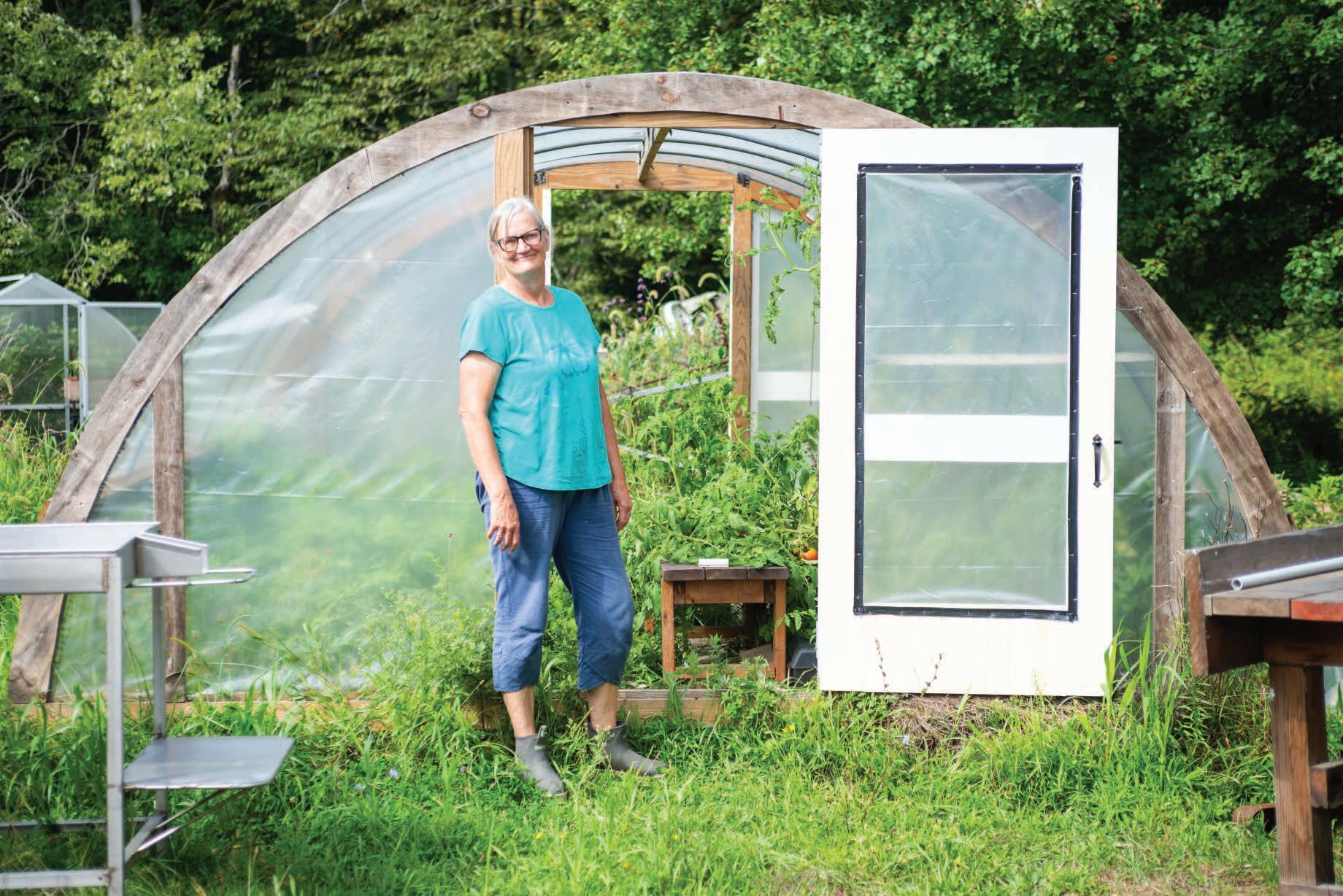
The key to getting the most out of the structure during the colder months, Hei di says, is layering on the warmth. Before planting greens and other spring crops, she will lay down a black plastic sheet to warm up the soil. In late fall and winter, she often covers her crops by arranging fabric row cover over mini-hoops, effec tively creating a tunnel within a tunnel that keeps the ambient temperature significantly higher than outside. With this method, you can harvest greens ju diciously all winter, especially if you've planted them in mid-fall to get a good

tunnels). I cover the hoops with plastic greenhouse film in late spring and tuck tomato seedlings and dahlia plants under them to harden the plants off before the soil warms up.
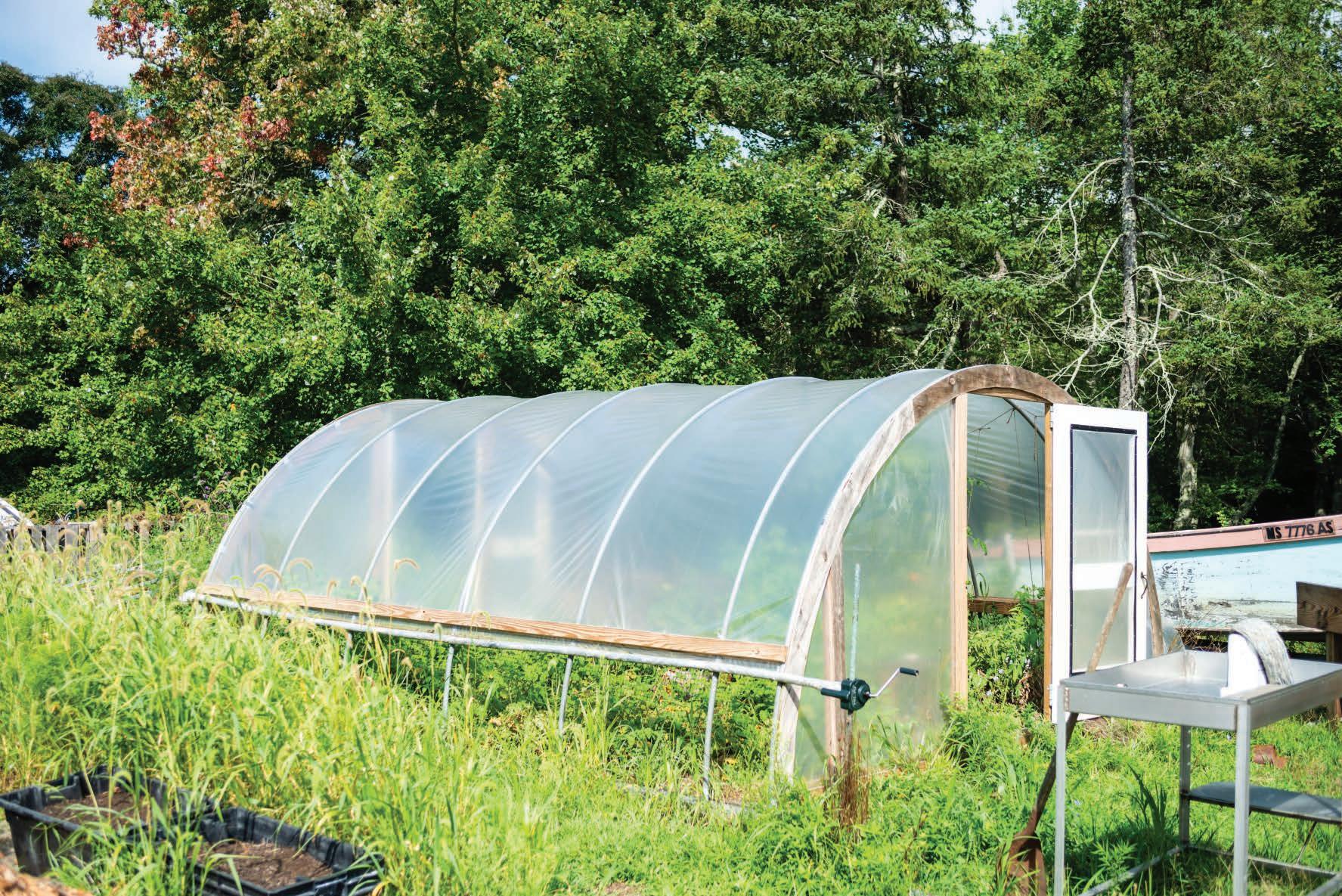
In spring I cover the hoops tightly with lightweight fabric row cover both to warm the environment for baby lettuce and other seedlings and to keep out the inevitable cabbage moths that devastate kale and bok choy for as long as I can. I use clothespins, binder clips, bricks, boards and anything else that will hold the fabric in place.
In early winter, I put one or two layers of row cover back over fall greens to keep them going for as long as possible. When we have less than 10 hours of daylight, they won’t really grow. But if I’ve start ed enough plants I can still harvest lightly through the winter.
A DIY alternative to wire hoops is PVC pipe cut into various lengths. To keep the PVC hoops upright and stable, tuck them over short stakes in the ground or use them in container beds where the wood frame will help stabilize them.
— Susie Middleton
Sources
Wire hoops, fabric row covers of different weights, greenhouse film, met al pipe benders, sidewall cranks and clips are available from Johnny’s Seeds (johnnyseeds.com) and other online gardening sources. Note: Do not buy just any plastic from the hardware store; greenhouse film will hold up much longer. Metal conduit pipe for bending into hoops, as well as PVC pipe, can be bought at Home Depot and other lumber and electrical supply stores.
THE VINE · Page 21
In an effort to be more self-sufficient, Marie Larsen built a small hoop house not far from her large vegetable garden in a spot protected from wind. Like the Ewings, Marie can ventilate her hoop house by rolling up the sides with a sidewall handwall crank.
Susie Middleton
headstart before winter.
All the gardeners agree that one of the biggest bonuses of a hoop house is the ability to grow a variety of greens, both for salads and cooking, in the shoulder seasons. Heidi appreciates bountiful and quick sprouting kale, especially when she doesn’t have to dig through the snow to get it. Lynne has become disillusioned with its virility, saying “Kale is a weed. I don’t even plant kale anymore.” Marie is a spinach fan; she got several harvests per plant from her hoop house brood. Along with more conventional greens, Rachael said that claytonia, also known as miner’s lettuce, is a bountiful and oft forgotten winter crop.
But a hoop house is not merely a sea son extender; it can also boost your peak harvest. At the height of summer, Marie’s hoop house is resplendent with bushy tomatoes, both for eating and for sauce. (Seed catalogues such as Johnny’s offer tomato varieties that perform best in hoop house or greenhouse conditions.) Rachael uses her hoop house not only for heat-hungry crops such as tomatoes
and watermelon, but for frost-sensitive perennials like her pomegranate tree and lemon verbena.
Gardening in a hoop house is an inten sive use of soil, so amendments are es sential. “You have to pay attention to the soil,” says Rebecca, “The minute you take something out feed the soil.” She makes extensive use of wood chips, chicken ma nure and compost, as well as fish emul sion from her husband’s fishing trips. Keeping the soil healthy helps to control pest populations that can thrive in the warm environment of a hoop house.
Certainly with the expanded window of growing that a hoop house offers there comes more opportunity for garden cha os and conundrums. But that’s really what gardening is all about – grabbing on to that chaotic, photosynthetic world of the plant and holding on for dear life. “Just start with a plan,” Marie recom mends. “Then things might go crazy, but you at least have a solid base.”
Thomas Humphrey is a reporter for the Vineyard Gazette.


In Marie Larsen's hoop house, tomatoes grow quite large and yields are excellent. In win ter months, Marie supplies her family with greens. Spinach grows especially well for her.
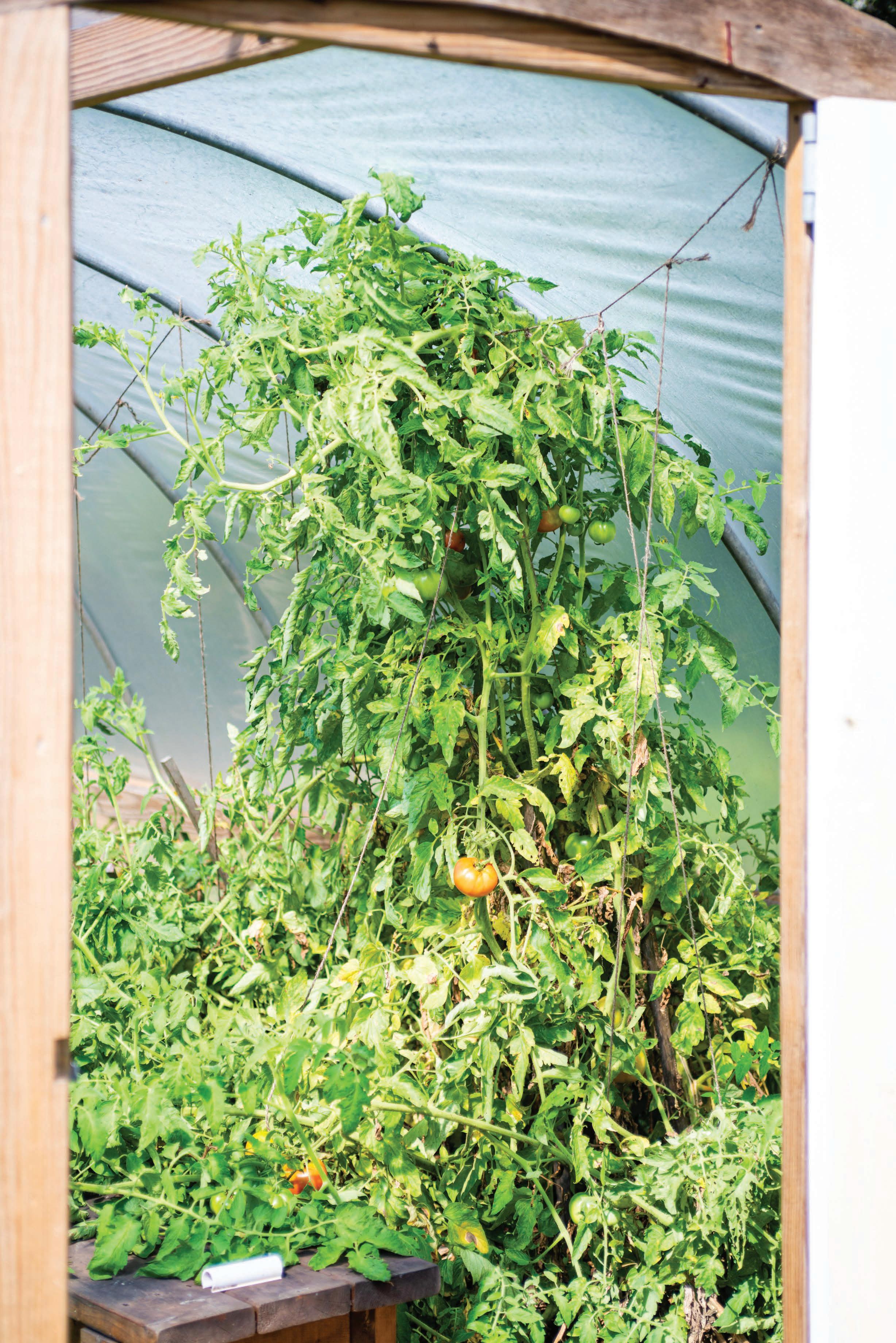
Page 22 · THE VINE
BY
LAND HO!
BY NICOLE FULLIN • ILLUSTRATIONS BY CHRIS BURRELL
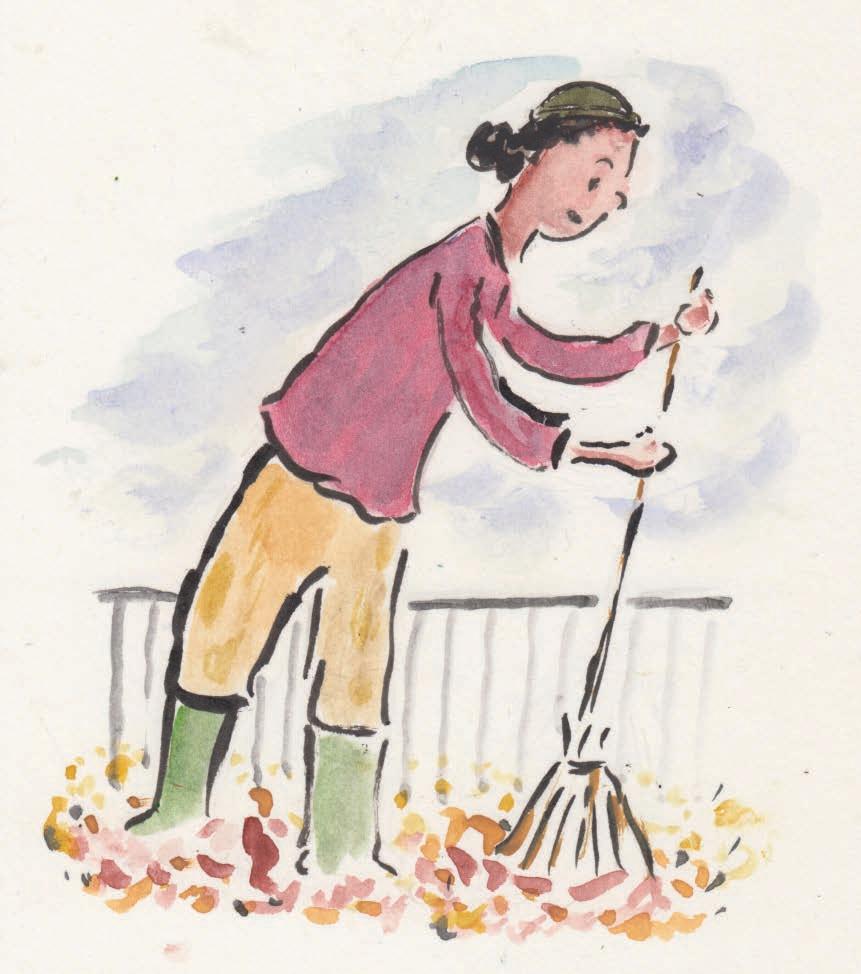
90
YARD ARM. Clean up your yard and garden this fall with the help of Island landscapers - there are more than 90 companies to choose from!
1,008 sq.ft.
AMONG THE TREES. Polly Hill Arboretum in West Tisbury was given approval over the summer to build two 1,008-square-foot housing units for employees on its property.
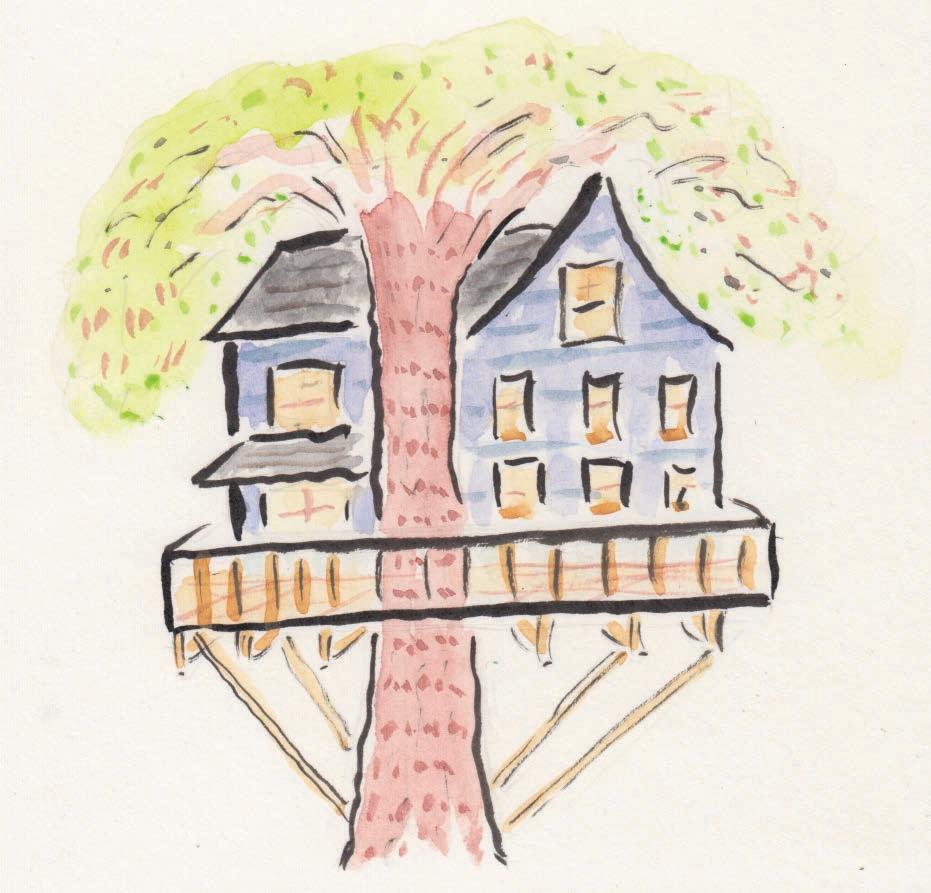
31%
GOING DOWN. By the end of August 2021, 412 real estate transactions had occurred on the Island. By the end of August 2022, there had only been 285 transactions – a 31 percent decrease from the previous year.
65% Increase
REVERSE COMMUTE. This April, the two ear liest ferries to the Island carried more than 9,700 walk-on commuters to the Island. That’s a 65 percent increase from the same month a decade ago.
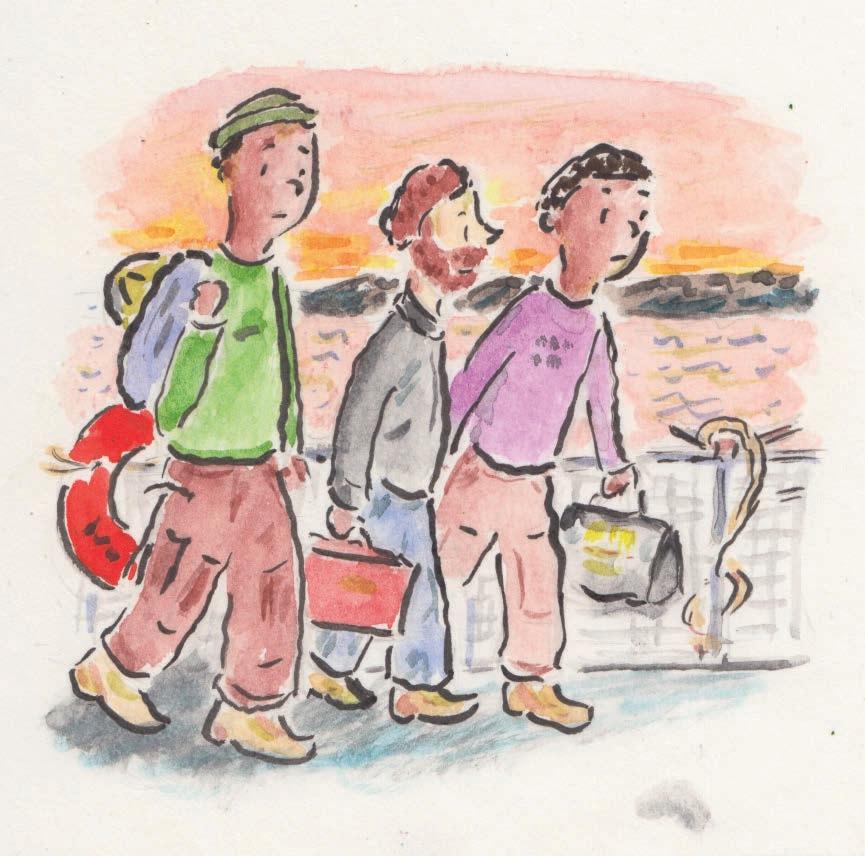
SOLD!
First Half of 2022 Real Estate Sales on the Vineyard

most expensive single-family home sold.
least expensive single-family home sold.
most expensive piece of land sold.
least expensive piece of land sold.
THE VINE · Page 23
DECREASE
$14,000,000
$500,000
$12,250,000
$160,000
THE NUMBERS





































 BY THOMAS HUMPHREY • PHOTOS BY RAY EWING
BY THOMAS HUMPHREY • PHOTOS BY RAY EWING














 BY JANET NEWTON • PHOTOS BY JEANNA SHEPARD
BY JANET NEWTON • PHOTOS BY JEANNA SHEPARD


















